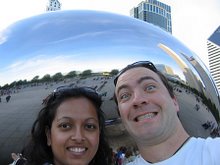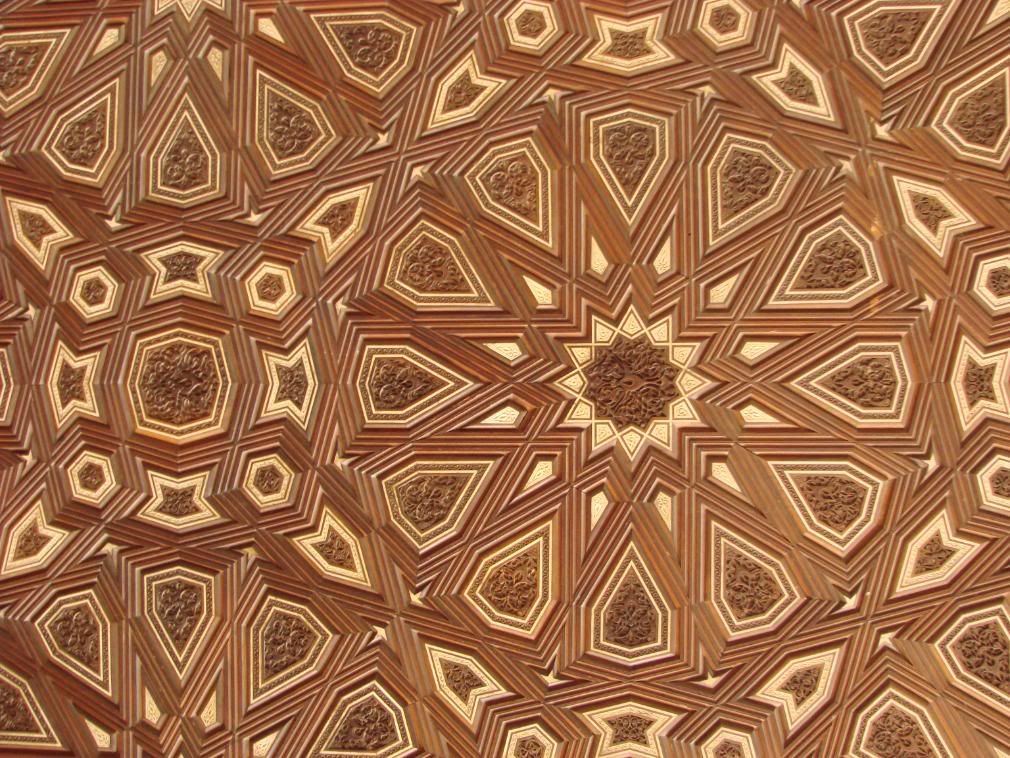 quoted us what seemed a reasonable rate. Of course, he then took us to a different hotel that was a dump and we told him to take us to the one on the brochure. When we arrived, the hotel informed us the tout had lied about the price and also had lied about including the transfer from the airport. After arguing with him for much too long, we finally paid him half of what he wanted and told the hotel ‘manager’ to pony up the rest since he was trying to convince us we should just pay him. We planned to check out of the hotel the next day, but our plans were sidetracked by a three-hour tour sales speech from the ‘manager’ from the previous night. We don’t know why we let him waste our time and by the time we checked the other hotel, it was booked up, so we begrudgingly returned to the New Palace Hotel. Although he stuck around for a couple days, the ‘manager’ eventually disappeared from the hotel once he realized we were not going to book a tour through him. In all likelihood, he was a tour agent tout in cahoots with the taxi driver to completely scam us by overcharging us for a tour. When we came to this conclusion, we decided we’d ‘forget’ to return the old guide book they had loaned us.
quoted us what seemed a reasonable rate. Of course, he then took us to a different hotel that was a dump and we told him to take us to the one on the brochure. When we arrived, the hotel informed us the tout had lied about the price and also had lied about including the transfer from the airport. After arguing with him for much too long, we finally paid him half of what he wanted and told the hotel ‘manager’ to pony up the rest since he was trying to convince us we should just pay him. We planned to check out of the hotel the next day, but our plans were sidetracked by a three-hour tour sales speech from the ‘manager’ from the previous night. We don’t know why we let him waste our time and by the time we checked the other hotel, it was booked up, so we begrudgingly returned to the New Palace Hotel. Although he stuck around for a couple days, the ‘manager’ eventually disappeared from the hotel once he realized we were not going to book a tour through him. In all likelihood, he was a tour agent tout in cahoots with the taxi driver to completely scam us by overcharging us for a tour. When we came to this conclusion, we decided we’d ‘forget’ to return the old guide book they had loaned us.Despite these initial hassles, we were excited to start a new adventure. Cairo is a city that is one of the most visited in the world because of its ancient history, but it is also a bustling modern metropolis of close to 40 million people. The downtown area, where we were stayed, is lined with cafes where the male locals hang out smoking sheesha (flavored tobacco) out of houkas and drinking unfiltered black tea with lots of sugar (we would later marvel when one Egyptian added five heeping spoonfuls into his cup). The prevalence of smoking amongst males is a staggering 95% and for those like us who loathe 2nd hand tobacco smoke, we just had to grin and bear it.
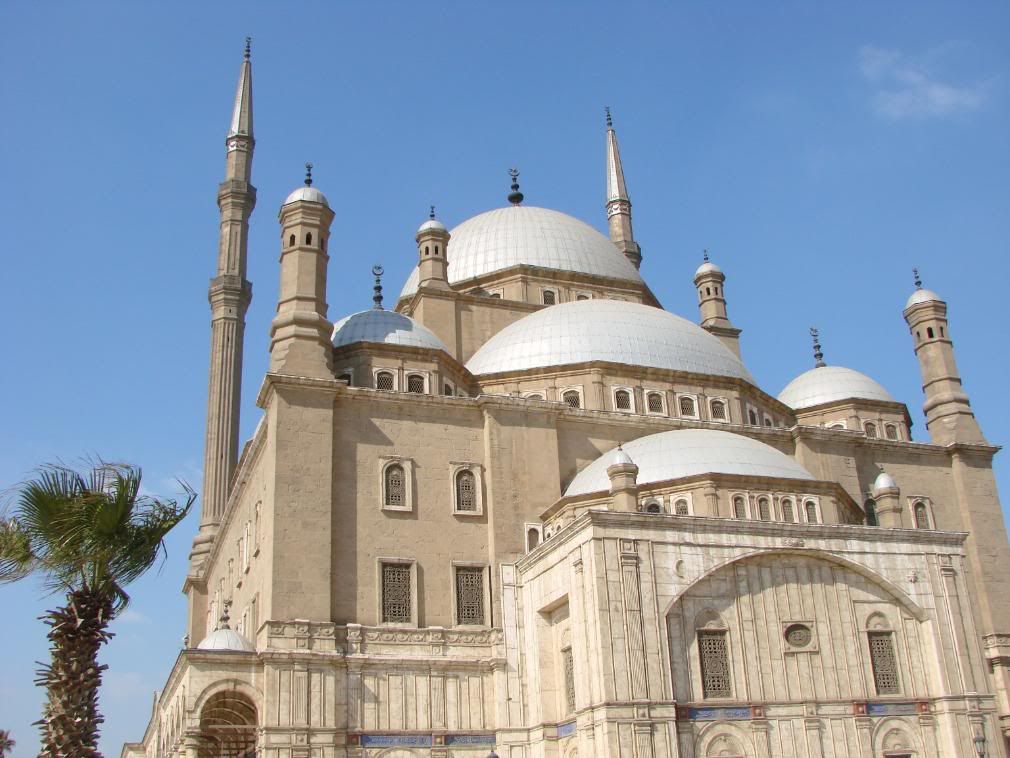 And, although we’ve been exposed to some awful traffic on our travels, Cairo’s was the worst yet because for the first time, as pedestrians, we worried about staying alive as we crossed the street at crosswalks since drivers ignored red lights, pedestrians, and sometimes even sped up as pedestrians crossed. We were thankful but surprised that we didn’t see anyone hit by cars. On the flip side, Cairo is a very safe city and we never felt worried about our safety other than when we had to cross the street. We also enjoyed the music emanating from the cafes and we grew to love Arab music during our six weeks in the Middle East. Finally, we marveled at how ‘clean’ Cairo was, which is a good example of how subjective our perceptions can be; having just arrived from India, the filthiest country in the world, Egypt seemed clean to us, when nearly everyone else remarked how dirty it was. We quickly dove into the local cuisine, and feasted on fresh shwarmas and yummy eggplant. Although the food was pretty good, we couldn’t help but compare it to one of our favorite restaurants in Chicago, Pita Inn. However, the sweets were absolutely delicious, even tastier than in India, and we returned to one of the local pastry shops every night to sample the various culinary treats.
And, although we’ve been exposed to some awful traffic on our travels, Cairo’s was the worst yet because for the first time, as pedestrians, we worried about staying alive as we crossed the street at crosswalks since drivers ignored red lights, pedestrians, and sometimes even sped up as pedestrians crossed. We were thankful but surprised that we didn’t see anyone hit by cars. On the flip side, Cairo is a very safe city and we never felt worried about our safety other than when we had to cross the street. We also enjoyed the music emanating from the cafes and we grew to love Arab music during our six weeks in the Middle East. Finally, we marveled at how ‘clean’ Cairo was, which is a good example of how subjective our perceptions can be; having just arrived from India, the filthiest country in the world, Egypt seemed clean to us, when nearly everyone else remarked how dirty it was. We quickly dove into the local cuisine, and feasted on fresh shwarmas and yummy eggplant. Although the food was pretty good, we couldn’t help but compare it to one of our favorite restaurants in Chicago, Pita Inn. However, the sweets were absolutely delicious, even tastier than in India, and we returned to one of the local pastry shops every night to sample the various culinary treats.During our time in Egypt, we were inundated with visual and aural expressions of the Islamic faith. One day we explored an area called Old Cairo, where it seemed as if there was an ancient Mosque on every single block. Each morning at about 5 am, the amplified sound of the muezzin asking the faithful to attend prayers at the mosque. Earplugs were thus a necessity for sleep. Friday is their holy day and almost everything, except stores and public transportation, were closed. Plus, since Muslims pray five times a day, we heard the prayers often and since there are so many mosques, at times the city was so loud we wished we could have walked with earplugs.
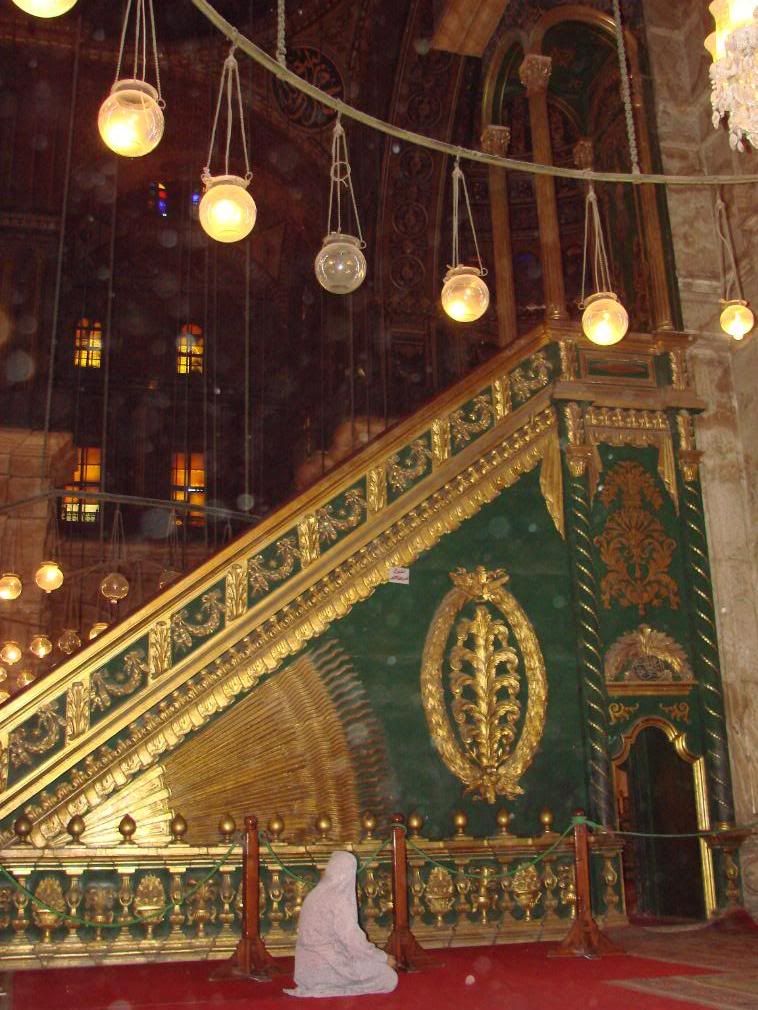 All of the local televisions stop broadcasting during prayer times as well. We visited the Citadel, an ancient fortress that contained an incredibly mosque, a war museum, and great views of the city. Since it was a clear day, we could see the Pyramids even though they were about 10 miles away. In the mosque, it was fascinating to see the faithful embarking in their prayers while hordes of tourists (like us) snapped photographs. The war museum was massive, which is not surprising given Egypt’s long and war-filled history. What was surprising is the way it seemed to glorify war. And, like many of the tourist activities, the movement within the museum was highly controlled by the government, and we had to go through the entire thing in order to get to the exit (i.e., we couldn’t turn around)!
All of the local televisions stop broadcasting during prayer times as well. We visited the Citadel, an ancient fortress that contained an incredibly mosque, a war museum, and great views of the city. Since it was a clear day, we could see the Pyramids even though they were about 10 miles away. In the mosque, it was fascinating to see the faithful embarking in their prayers while hordes of tourists (like us) snapped photographs. The war museum was massive, which is not surprising given Egypt’s long and war-filled history. What was surprising is the way it seemed to glorify war. And, like many of the tourist activities, the movement within the museum was highly controlled by the government, and we had to go through the entire thing in order to get to the exit (i.e., we couldn’t turn around)!And of course we visited the pyramids of Giza, the only of the seven ancient wonders that are still standing, on a guided day trip along with the ancient city of Memphis and the necropolis of Saqqara. The pyramids, three large and six small, were an amazing sight surrounded by tourists, locals, and camels for hire. Our guide helped us take some hilarious pics, and this one's for all those readers who remember the 80s.
 We entered the tunnel of one of the large pyramids which was dark, narrow, and stiflingly humid. Two people could barely pass one another and we had to stay hunched over the entire time, save for a brief reprieve in the middle. The people coming out were panting as we were going in and at one point it got so dark and claustrophobic that Priti started turning around but Jason supported her through this exposure therapy process (for professionals only–hah!). After the difficult descent, we reached the center where there was an empty tomb; a bit anti-climactic but still interesting to see.
We entered the tunnel of one of the large pyramids which was dark, narrow, and stiflingly humid. Two people could barely pass one another and we had to stay hunched over the entire time, save for a brief reprieve in the middle. The people coming out were panting as we were going in and at one point it got so dark and claustrophobic that Priti started turning around but Jason supported her through this exposure therapy process (for professionals only–hah!). After the difficult descent, we reached the center where there was an empty tomb; a bit anti-climactic but still interesting to see. 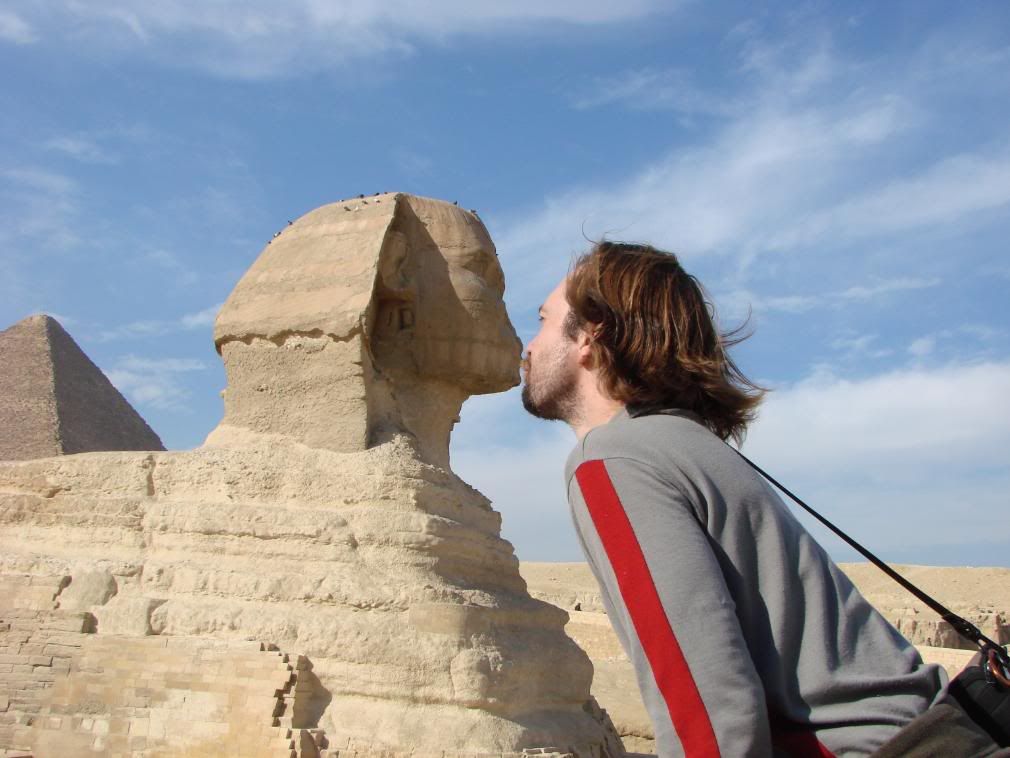 Saqqara is 5000 years old, was originally one huge cemetery, and the tombs are lined with sunrays. Many of the limestones of the tombs were taken to build homes and Mosques in Old Cairo about 4500-5000 years ago and it was sad to see the top of the Step Pyramid at Saqqara was missing its top due to the long-gone thieves. We learned from our guide that statues usually have the left foot forward which means to follow your heart and if they had hands across their chest, this indicated death.
Saqqara is 5000 years old, was originally one huge cemetery, and the tombs are lined with sunrays. Many of the limestones of the tombs were taken to build homes and Mosques in Old Cairo about 4500-5000 years ago and it was sad to see the top of the Step Pyramid at Saqqara was missing its top due to the long-gone thieves. We learned from our guide that statues usually have the left foot forward which means to follow your heart and if they had hands across their chest, this indicated death.Then we were off to the Egyptian museum, which is so massive that it would take months to see every artifact on display. In addition to its shear size, the place is always jam packed with large tour groups, which make it difficult to maneuver around. Instead, we spent one frenetic afternoon hitting the highlights, including the sarcophagi and death mask of King Tut, which were made out of pure gold. At the Egyptian museum we learned that people were buried with animals for a variety of reasons: as food so they would not starve in the afterlife, as sacrifices to various Gods, and of course as companions (Jason decided he’s taking his cats Billy and Simone with him into the afterlife).
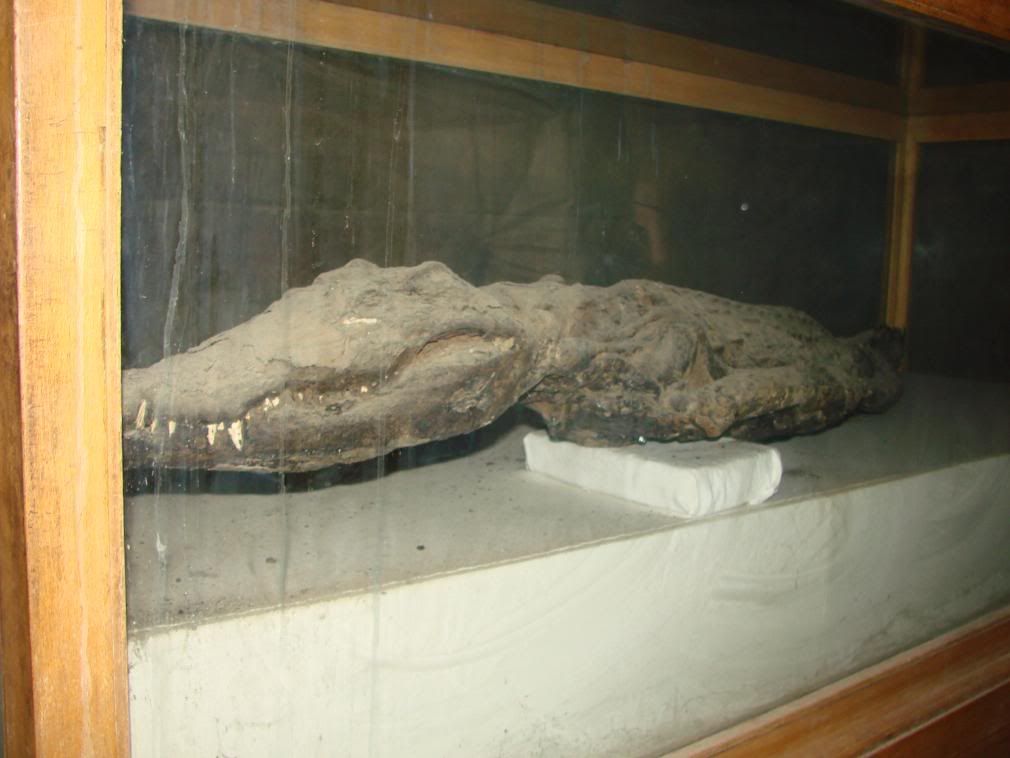 Jason bought an extra ticket to see the mummy room, which contains nine bodies and is not for the faint of heart. It was amazing how well-preserved the bodies were and a few of them even still had their hair. The only annoying aspect was that he wasn’t allowed to bring in his camera, even though just about every other person was taking pictures with their cell phones. Afterwards, we walked along the Nile River and enjoyed the view of the many boats.
Jason bought an extra ticket to see the mummy room, which contains nine bodies and is not for the faint of heart. It was amazing how well-preserved the bodies were and a few of them even still had their hair. The only annoying aspect was that he wasn’t allowed to bring in his camera, even though just about every other person was taking pictures with their cell phones. Afterwards, we walked along the Nile River and enjoyed the view of the many boats.That evening, a local Egyptian named Khaled helped us change our flight to Kenya (we are no longer going there due to the recent violence). Afterwards, he invited us to tea, smoke sheesa and watch the African Cup match between Egypt and Kenya. Priti was the only woman in the entire café and Egypt won! This was followed by the best food in Cairo called Koshary which is a mix of lentils, pasta, fried onions, and spices. Delicious!!! We found the Egypt had some of the nicest people we’ve met on our trip but at the same time there are a lot of jerks who are always trying to scam tourists. We could list a dozen examples but we’ll just leave it at that.
The next day, we traversed five hours west by bus to Bahariyya Oasis, a haven of green in the middle of the desert. This area was filled with palm trees and Bedouin culture. The desert in Egypt is barren outside of the oases.
 Nothing grows – no trees, no shrubs, not even weeds. The contrast between an oasis which has palm trees and water to the Egyptian desert is extreme. Tucson, Arizona seems like the Northwest US in comparison to the desert in Egypt! On a 4WD tour, we saw the Salt Lake which has the run-off of agriculture water but there is so much salt in the ground that the water foams at the edge. In the vicinity, Pyramid Mountain is a natural mountain that looks just like one of the pyramids near Cairo. It is famous for dinosaur fossils found there in the early 20th century. Nearby, we found full skeletal remains of a cow. The desert is deadly! Then we went to a camel farm where one of the camels stuck her head over the stone wall and wanted to be petted the entire time.
Nothing grows – no trees, no shrubs, not even weeds. The contrast between an oasis which has palm trees and water to the Egyptian desert is extreme. Tucson, Arizona seems like the Northwest US in comparison to the desert in Egypt! On a 4WD tour, we saw the Salt Lake which has the run-off of agriculture water but there is so much salt in the ground that the water foams at the edge. In the vicinity, Pyramid Mountain is a natural mountain that looks just like one of the pyramids near Cairo. It is famous for dinosaur fossils found there in the early 20th century. Nearby, we found full skeletal remains of a cow. The desert is deadly! Then we went to a camel farm where one of the camels stuck her head over the stone wall and wanted to be petted the entire time. 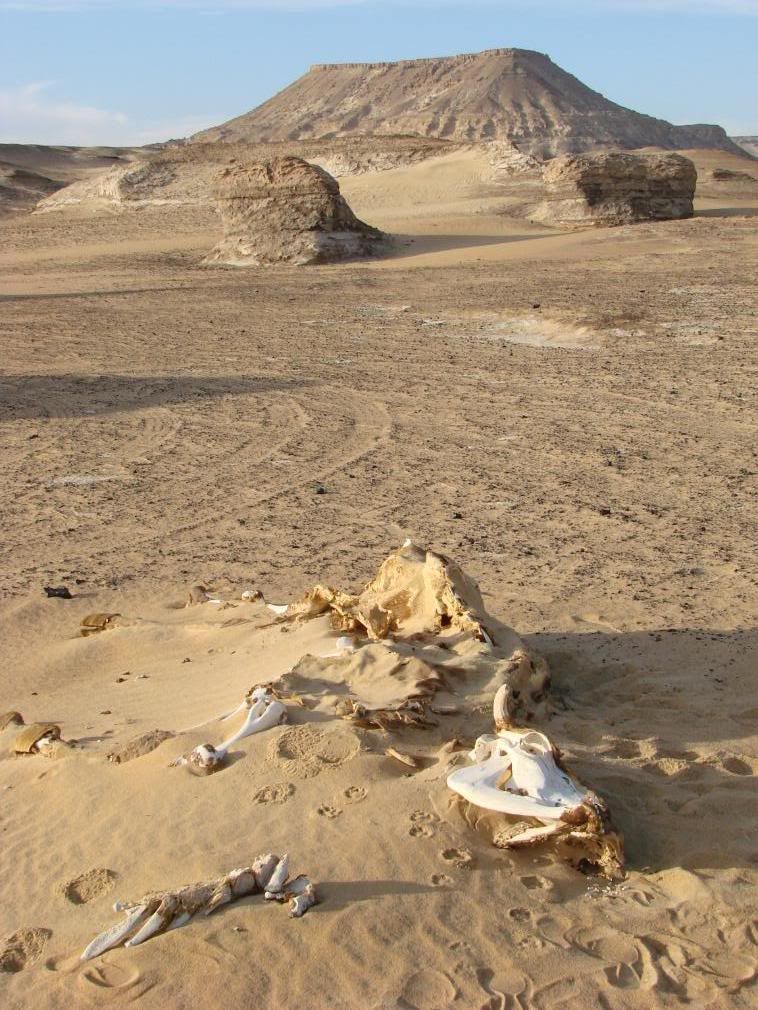 Camels are so cool! The tour guide told us that often, the camel man will feed his camel marijuana so they remain dazed and chill. Maybe that’s why Jason’s camel kept chewing and eating in Jaiselmer, India. Hmmm, makes sense now. We proceeded to Crystal Mountain which was entirely made of quartz crystal rocks. Due to being protected land, we couldn’t pick up any of the crystals although Priti imagined making thousands and thousands of pieces of jewelry from the crystal stones. (Alas, no crystal necklaces as gifts for those at home). It was not that spectacular in the sense of how it looked from afar until you got close to each sparking piece and observed the way the light was reflected on the mountain.
Camels are so cool! The tour guide told us that often, the camel man will feed his camel marijuana so they remain dazed and chill. Maybe that’s why Jason’s camel kept chewing and eating in Jaiselmer, India. Hmmm, makes sense now. We proceeded to Crystal Mountain which was entirely made of quartz crystal rocks. Due to being protected land, we couldn’t pick up any of the crystals although Priti imagined making thousands and thousands of pieces of jewelry from the crystal stones. (Alas, no crystal necklaces as gifts for those at home). It was not that spectacular in the sense of how it looked from afar until you got close to each sparking piece and observed the way the light was reflected on the mountain.The highlight of the tour, indeed one of the highlights of the entire trip thus far, was the White Desert which is called Sahra al-Beida. This place felt like another planet. Blinding white rock formations were everywhere and came in myriad shapes, some of which were familiar, such as animal profiles and massive mushrooms.
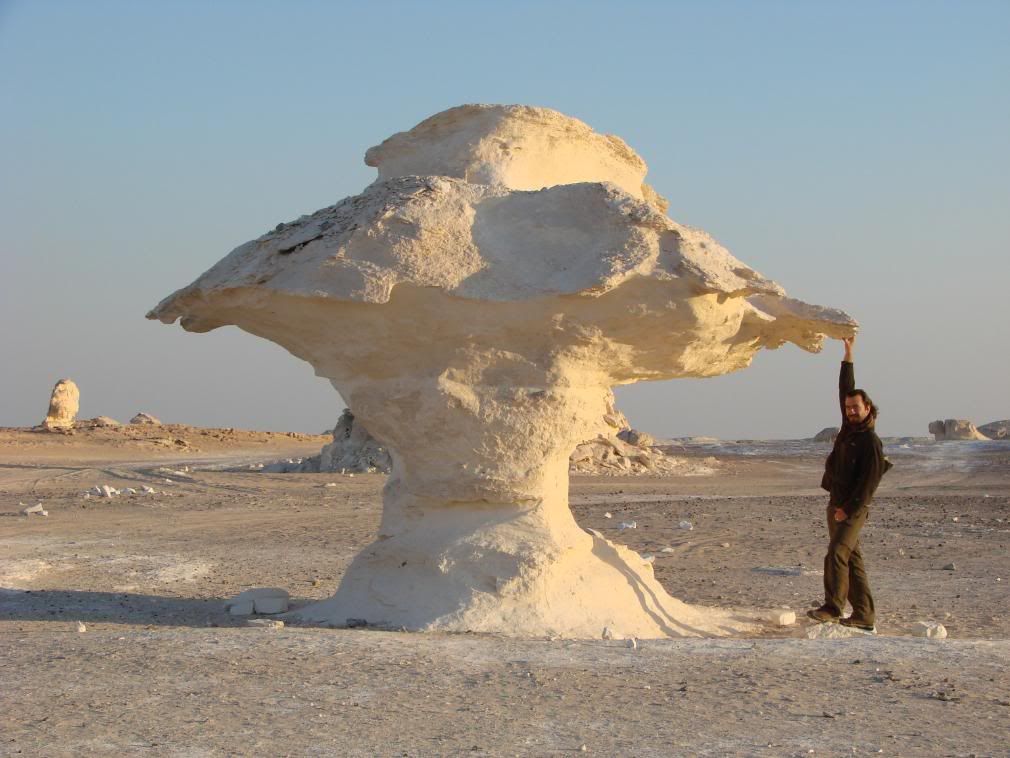 They were shaped by wind erosion and were surreal. At sunset the sky was alit and pink and the silhouettes of the white rock formations became even more spectacular. The sand around the white formations, littered with sparkling quartz, gives the landscape the feeling of snow with the sunlight beaming on it eerily at times.
They were shaped by wind erosion and were surreal. At sunset the sky was alit and pink and the silhouettes of the white rock formations became even more spectacular. The sand around the white formations, littered with sparkling quartz, gives the landscape the feeling of snow with the sunlight beaming on it eerily at times.After camping in the desert under the star filled sky, we awoke early the next morning and adventured to the Black Desert. It was wild to see the desert transformed from white to black. The Black desert was formed over a millennia as wind eroded the mountains and spread a fine black powder over the ground. It ended with a small, black volcano shaped mountain, part of a fault that runs through Bahariyya Oasis. We also went to Gebel az-Zuqaq which is a mountain known for red, yellow, and orange streaks in the limestone rock base. It was pretty cool and we took plenty of pictures of all the things that we saw on this excursion. Although we camped in the desert, for those itching to go to Egypt, it can all be seen in a day.
We met some cool people on the 4WD adventure. Christine, a Canadian who currently has been living in Taiwan for three years as an English teacher, shared a story about ghost wives. When a family member loses a young daughter who has not been married, they leave money on the street or something of value like a watch or jewelry. The man who picks it up is then obligated to marry the ghost wife and she even becomes the first wife if he is already married! He has no choice in the matter or else he will be haunted by the female ghost. His family and the ghost wife’s family have an actual wedding ceremony and party.
 Shangwei, Christine’s Taiwanese boyfriend, refuses to pick anything up from the street. Anyways, Taiwanese people think that the ghost wife and the man who picks up the item of value are somehow linked spiritually and that is why the man is obligated to marry the ghost bride. Linda, a fellow American who has worked in radio with Tavis Smiley and Air America, was recently in India and shared that she became spiritual while in India. She is one of many people who have told us that they found spirituality while in India. She described being in a silent ashram in Northern India and could not speak to anyone, not even her roommate, for 10 days and how during the day, the silent meditation was in a room full of other people. She described being at peace with herself since her ten days of silence. It was hard to imagine being silent for that duration of time. Unfortunately, they left after the first day and our camping companions were a French couple who were just about the least friendly people we’ve met.
Shangwei, Christine’s Taiwanese boyfriend, refuses to pick anything up from the street. Anyways, Taiwanese people think that the ghost wife and the man who picks up the item of value are somehow linked spiritually and that is why the man is obligated to marry the ghost bride. Linda, a fellow American who has worked in radio with Tavis Smiley and Air America, was recently in India and shared that she became spiritual while in India. She is one of many people who have told us that they found spirituality while in India. She described being in a silent ashram in Northern India and could not speak to anyone, not even her roommate, for 10 days and how during the day, the silent meditation was in a room full of other people. She described being at peace with herself since her ten days of silence. It was hard to imagine being silent for that duration of time. Unfortunately, they left after the first day and our camping companions were a French couple who were just about the least friendly people we’ve met.After our couple of days in the desert, we started our tour of temples in Egypt. The first stop was the city of Aswan after a miserably long overnight train ride sans reclining seats, even though they were considered first class. (How we missed the trains of India with berths.) Aswan is Egypt’s southernmost city and unlike Cairo, which was having its coldest desert winter in decades, Aswan was warm, toasty, and picturesque with feluccas (traditional Egyptian sailboats) scattered on the Nile River. In ancient times, the city was the crossroads of caravans and a gateway to Africa. Immediately after arriving at our hotel, we were ushered to start the tour of Aswan. Despite how hurried our tour guide seemed, we waited 40 minutes for the van driver. We soon learned that if it was about the tour guide’s or driver’s time, then we should hurry but
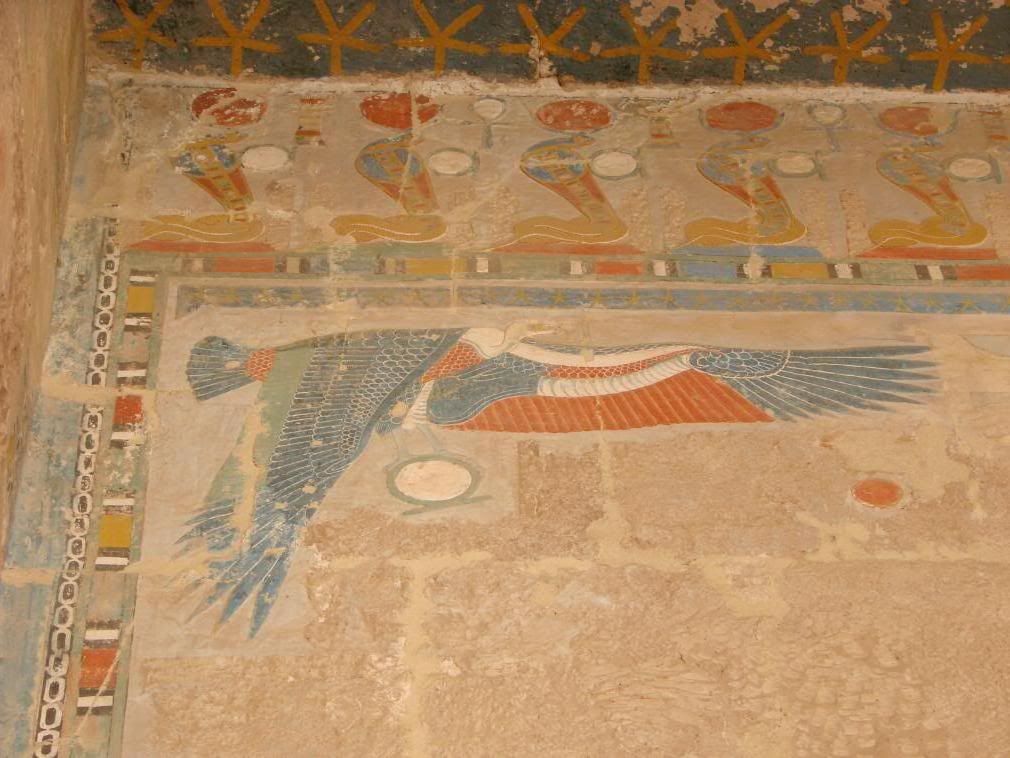 otherwise, most of the tour guides didn’t care if tourists had to wait. Hence, the tour started an hour later although the tour people kept saying “two minutes” while everyone in the van grumbled. Although we were supposed to visit the High Dam, we were told, due to shortage of time (!), that we would have to see the High Dam tomorrow and today only had time for Temple of Isis at Philae. From the tour guide: Philae means friends or couples. The original island on which the temple of Isis stands became flooded after the Egyptian government opened the High Dam. So then, they moved the entire temple and reconstructed it from 1972-1980! Originally it was built during Alexander the Great era (around 326 BC).
otherwise, most of the tour guides didn’t care if tourists had to wait. Hence, the tour started an hour later although the tour people kept saying “two minutes” while everyone in the van grumbled. Although we were supposed to visit the High Dam, we were told, due to shortage of time (!), that we would have to see the High Dam tomorrow and today only had time for Temple of Isis at Philae. From the tour guide: Philae means friends or couples. The original island on which the temple of Isis stands became flooded after the Egyptian government opened the High Dam. So then, they moved the entire temple and reconstructed it from 1972-1980! Originally it was built during Alexander the Great era (around 326 BC).During our many visits to various temples, we learned a lot about the different gods of ancient Egypt and the mythology. One of the more entertaining stories involved an incestuous love between the brother and sister gods Osiris and Isis (goddess of beauty, love and magic). After they fell in love, their older brother became jealous and had a gold coffin made to fit Osiris. This older brother threw a party during which he offered the gold coffin to whoever fit in it.
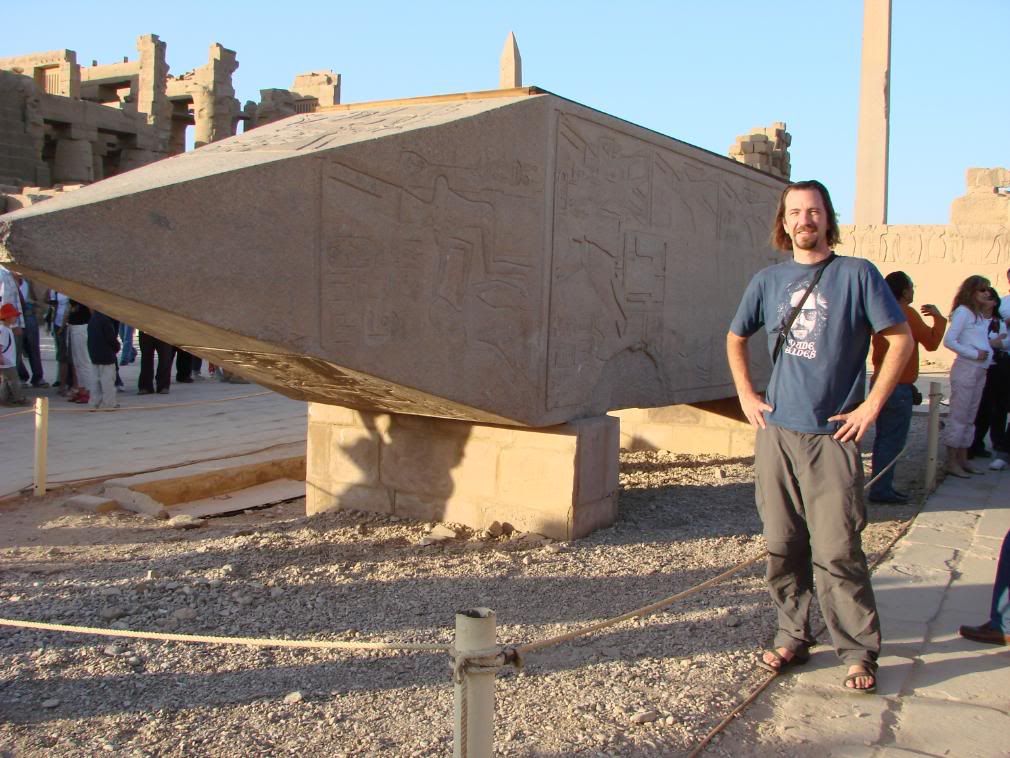 Of course, Osiris fit perfectly, was shut inside of it, and then his body was dismembered into fourteen pieces and discarded throughout Egypt. Isis, grieving over her lover/brother, used her magic to transform her body into a vulture and searched all over Egypt for him. And during that search she gave birth to their son Horus who is symbolized by a hawk due to her form as a vulture. She found 13 of the 14 pieces of Orisis’s body and wept over the very important missing body part, thus causing the flooding of the Nile River. The lost body part of the God Osiris was then symbolized by a giant obelisk, a phallic symbol which is found throughout Egypt.
Of course, Osiris fit perfectly, was shut inside of it, and then his body was dismembered into fourteen pieces and discarded throughout Egypt. Isis, grieving over her lover/brother, used her magic to transform her body into a vulture and searched all over Egypt for him. And during that search she gave birth to their son Horus who is symbolized by a hawk due to her form as a vulture. She found 13 of the 14 pieces of Orisis’s body and wept over the very important missing body part, thus causing the flooding of the Nile River. The lost body part of the God Osiris was then symbolized by a giant obelisk, a phallic symbol which is found throughout Egypt.After visiting the Temple of Isis, we walked through Aswan along the Nile River which flowed from South to North around beautiful boulders and small islands in the river. Because of the flow of the Nile, southern Egypt is referred to as ‘upper’ while northern Egypt is called ‘lower.’ We visited the old Fatimid Cemetery which had a collection of low, mud-brink buildings with domed roofs and mausoleums dating from the 9th century. This was followed by a wonderful riverside dinner and then a short visit to the Nubia Museum where we learned about Nubian culture.
We had to wake up at 4 am the next day so we went to bed fairly early. So far on this world-wind adventure, we often have opted to do things on our own if we can. In Egypt, however, to travel to specific sites you have to be part of a convoy, an armed police escort, whether you are part of a tour group or hire a private taxi to the site of interest. This was the government’s response to
 a bombing of a tourist bus near Aswan which resulted in many deaths and the decline of the tourist economy. So the 3:45 am wake-up call from the hotel was not by choice but due to the 4:30 am departure time of the convoy to travel a few hours to the site of Abu Simbel where the majestic temples of Ramses II and Hathor were located. It was dark in the morning and all the tour buses, minibuses, and private taxis lined up alongside the main road with a police escort sandwiching both ends. Unfortunately, we weren’t able to sleep in the minivan since the driver disregarded lane lines around curves and despite all the vehicles having the same destination, the driver would quickly and sharply pass tour buses and minivans. The only thing redeeming about the transportation was the spectacular desert sunrise, the second of half a dozen sunrises in Egypt we would see.
a bombing of a tourist bus near Aswan which resulted in many deaths and the decline of the tourist economy. So the 3:45 am wake-up call from the hotel was not by choice but due to the 4:30 am departure time of the convoy to travel a few hours to the site of Abu Simbel where the majestic temples of Ramses II and Hathor were located. It was dark in the morning and all the tour buses, minibuses, and private taxis lined up alongside the main road with a police escort sandwiching both ends. Unfortunately, we weren’t able to sleep in the minivan since the driver disregarded lane lines around curves and despite all the vehicles having the same destination, the driver would quickly and sharply pass tour buses and minivans. The only thing redeeming about the transportation was the spectacular desert sunrise, the second of half a dozen sunrises in Egypt we would see.First, we went to the Temple of Ramses II, carved out of a mountain on the bank of the Nile River between 1274 and 1244, and rediscovered in the early 1800s when a Swiss explorer noticed a statues’ head sticking out of the sand in the Egyptian desert. Ramses II must have been a narcissist since as a Pharaoh, he deified himself and built this gigantic temple for himself and the ancient Egyptian gods Raharakhty, Amum, and Ptah. Ramses II had many, many wives and numerous children which often provoked the joke amongst Egyptian men when they tried to sell male tourists essential oils, that he would become like Ramses II. On the outside of the temple, there are four huge statues of Ramses II, three of which are completely intact.
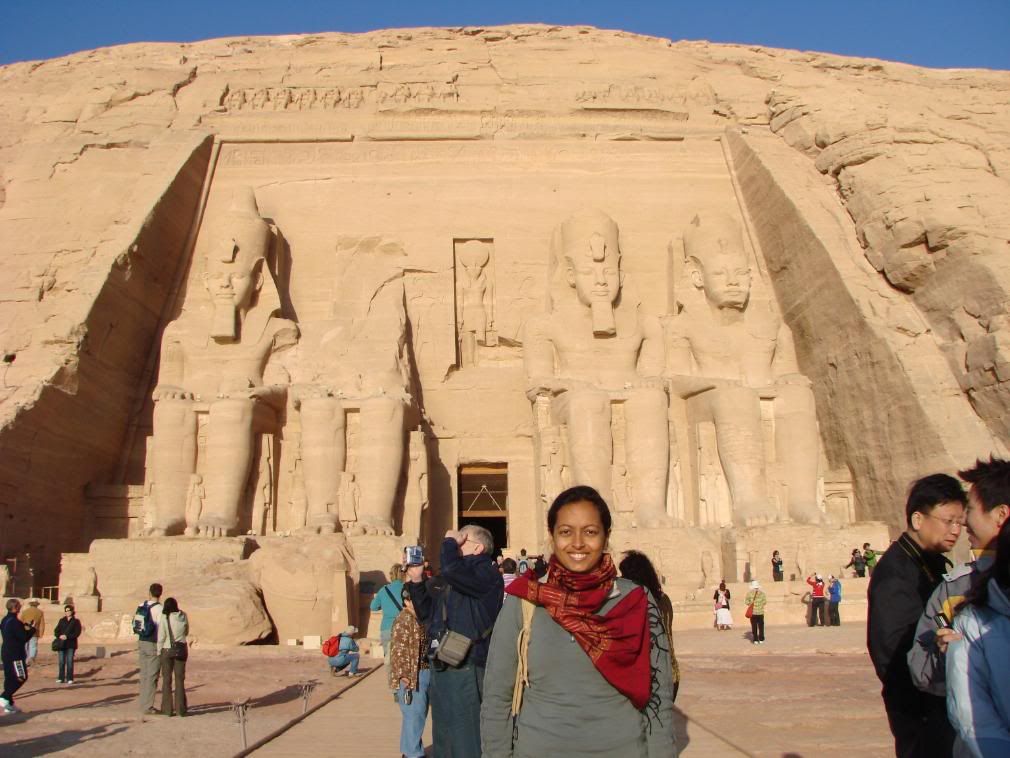 Inside the temple, there are more statues of the deified Pharaoh and Jason surreptitiously took a picture and was scolded by the ‘picture police’ who ignored the locals taking pictures with their mobile phones. The reliefs on the walls of the temple depict the pharaoh Ramses II in various battles, trampling over his enemies, and always victorious. At the back of the temple, the four gods sit on thrones and supposedly, every Feb 22 and Oct 22, the sunrise rays penetrate through the temple and illuminate the god of RaHarakhty, Amun, Ptah, and Ramses II. We were there about a week too early to see this phenomenon but we were told the place is an absolute zoo on those dates. Next we saw the Temple of Hathur which is next to the Temple of Ramses II. There was another ‘photo cop’ who seemed to target only foreign tourists but not the locals. This temple was magnificent and had statues of Ramses II’s Queen Nefertari and the gods Hathor (merciless god depicted as a cow) and Mut (god of Sky).
Inside the temple, there are more statues of the deified Pharaoh and Jason surreptitiously took a picture and was scolded by the ‘picture police’ who ignored the locals taking pictures with their mobile phones. The reliefs on the walls of the temple depict the pharaoh Ramses II in various battles, trampling over his enemies, and always victorious. At the back of the temple, the four gods sit on thrones and supposedly, every Feb 22 and Oct 22, the sunrise rays penetrate through the temple and illuminate the god of RaHarakhty, Amun, Ptah, and Ramses II. We were there about a week too early to see this phenomenon but we were told the place is an absolute zoo on those dates. Next we saw the Temple of Hathur which is next to the Temple of Ramses II. There was another ‘photo cop’ who seemed to target only foreign tourists but not the locals. This temple was magnificent and had statues of Ramses II’s Queen Nefertari and the gods Hathor (merciless god depicted as a cow) and Mut (god of Sky).After seeing both of these temples, we waited for the entire convoy and headed back toward Aswan. At around noon, we went to the dock and boarded our felucca for a two night sailing adventure. We learned that the four Chinese people already on the boat had waited for three hours to start sailing, complained to their tour agency and received a partial refund. We tried to not let this alter our excitement about sailing yet we were assertive in terms of seeing the sights that were promised to us by the travel agent. First, we went to Kitchener Island on the Nile River.
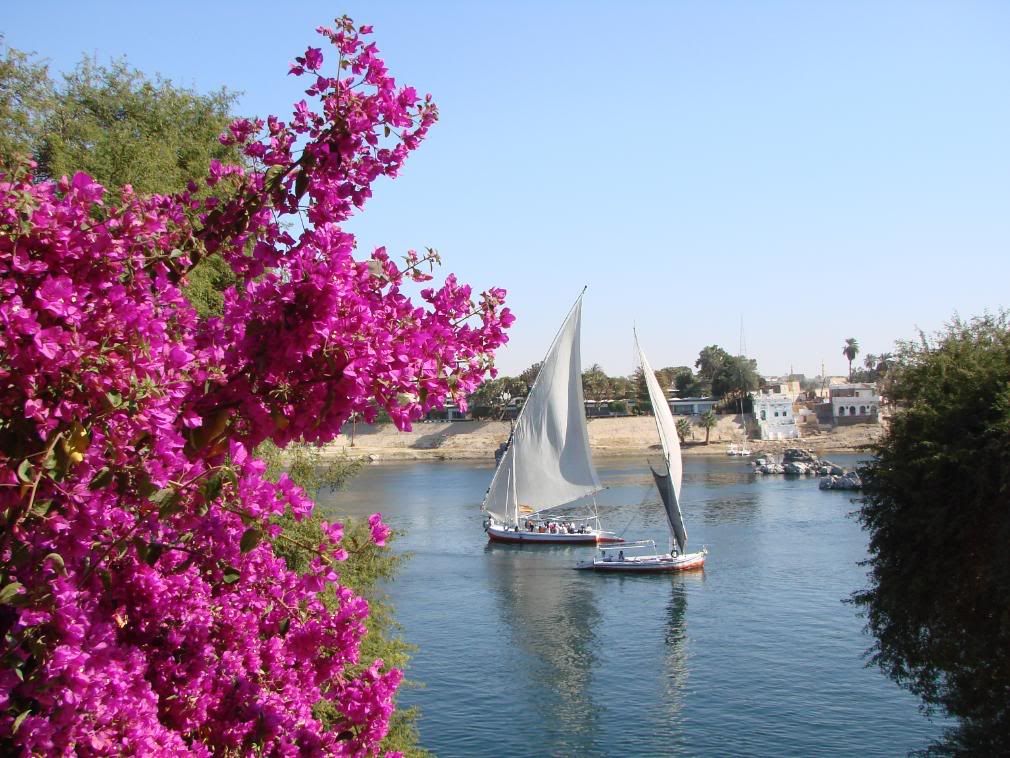 This island was a beautiful botanical garden with blooming bougainvilleas, roses, and other colorful flowers. It was peaceful walking around the island and watching the feluccas sail along the river. Later, we sailed around Elephantine Island which has a group of grey granite boulders that look like elephants bathing in the Nile River. On this island, we visited the ruins of Nebu from around 3000 BC which had temples, cemeteries, and a Nilometer which was used to measure the height of the Nile and to indicate if the harvest would be bountiful. The Nilometer affected the taxation system; the higher the river, the better the harvest and the higher the taxes on the merchants in ancient times.
This island was a beautiful botanical garden with blooming bougainvilleas, roses, and other colorful flowers. It was peaceful walking around the island and watching the feluccas sail along the river. Later, we sailed around Elephantine Island which has a group of grey granite boulders that look like elephants bathing in the Nile River. On this island, we visited the ruins of Nebu from around 3000 BC which had temples, cemeteries, and a Nilometer which was used to measure the height of the Nile and to indicate if the harvest would be bountiful. The Nilometer affected the taxation system; the higher the river, the better the harvest and the higher the taxes on the merchants in ancient times.After visiting those sites, we had some smooth sailing down the Nile and beheld this amazing sunset. We engaged with the sailors and fellow tourists, enjoying the breeze and the blue water of the Nile River.
 We slept overnight on the felucca and were relieved to not be woken up to the sound of the amplified voice of the muezzin calling the faithful to prayer. On our second day, we spent more time along the dock than sailing and in retrospect we would recommend doing only one night on the felucca and not the two nights like we did. On the felucca, Priti witnessed two more sunrises, making the total of sunrises seen in Egypt more than those seen in the last seven months of travels. Although Jason was annoyed about the lack of sailing on the second day, Priti enjoyed the sun and almost finished reading a four hundred page novel, Family Matters by Rohinton Mistry (highly recommended reading).
We slept overnight on the felucca and were relieved to not be woken up to the sound of the amplified voice of the muezzin calling the faithful to prayer. On our second day, we spent more time along the dock than sailing and in retrospect we would recommend doing only one night on the felucca and not the two nights like we did. On the felucca, Priti witnessed two more sunrises, making the total of sunrises seen in Egypt more than those seen in the last seven months of travels. Although Jason was annoyed about the lack of sailing on the second day, Priti enjoyed the sun and almost finished reading a four hundred page novel, Family Matters by Rohinton Mistry (highly recommended reading).During the day, one of the sailors anchored near his Nubian village and at his home, we had a milk coconut tea which was delicious. We walked around the village which has yellowish mud colored homes and the exterior walls are painted with domestic designs and of Egyptian men riding on donkeys, flowers, and other cultural images.
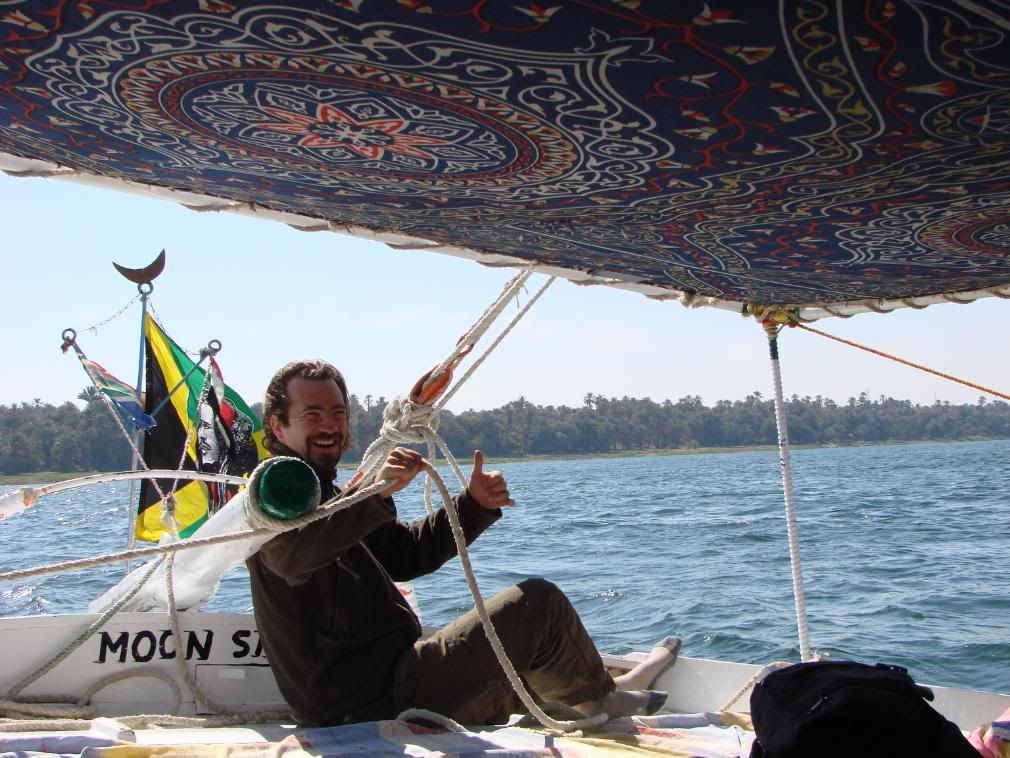 At night, we were disappointed to anchor next to a cement set of stairs instead of an isolated sandy bank area of the river. This however enabled Jason to hang out with the felucca workers on shore and watch the Egypt win the African cup for the second time in a row and seventh time overall. Priti opted to stay on the boat despite being a football fan and knew Egypt had won once the honking of horns were heard from the vehicles of the nearby town. For the remainder of our time in Egypt, Jason would shout out the names of the two star players (Abutrika & Zidane) when he wanted to make a connection with the locals.
At night, we were disappointed to anchor next to a cement set of stairs instead of an isolated sandy bank area of the river. This however enabled Jason to hang out with the felucca workers on shore and watch the Egypt win the African cup for the second time in a row and seventh time overall. Priti opted to stay on the boat despite being a football fan and knew Egypt had won once the honking of horns were heard from the vehicles of the nearby town. For the remainder of our time in Egypt, Jason would shout out the names of the two star players (Abutrika & Zidane) when he wanted to make a connection with the locals.The following morning, after a fitful, cold night of sleep on the felucca, we woke up again at the crack of dawn and took a jeep to the ancient site of the Temple of Kom Ombo, which is along the Nile River but different from other temples because everything is doubled and perfectly symmetrical. In ancient times, this area of the Nile used to have crocodiles basking on the river banks and the temple has mummified crocs. After walking around and imagining ancient Egpyt, we headed to the parking lot where we were required by the Egyptian government to travel again by convoy to Edfu to see the Temple of Horus which is supposedly the most well-preserved one in Egypt. This temple was started in 327 BC and wasn’t completed until 57 BC by Cleopatra’s father. (And we thought construction in the USA was slow!)
After checking out the site, we were again herded by convoy to Luxor. This time, due to the position of our vehicle, we could actually see the police escorts. We weren’t sure if traveling in a convoy actually makes tourists more or less of a target but since Eygpt started requiring convoys, there have been no attacks against tourists. By the time we reached Luxor, it was mid-afternoon and we were starving, ate an awful babbaganoush at the hotel, and headed to see the ancient Temple of Karnak through a pre-arranged tour. This place was huge and everything was on a gigantic scale. It was built and added to for 1500 years and one of the most important places of worship during ancient Egypt. Almost every Pharoah left their mark here. The temple contained an enormous hall, “The Great Hypostyle Hall,” with a forest of 134 unbelievably huge papyrus shaped stone columns. These stone columns are bigger than any we have ever seen.
 Although we didn’t try it, it would take half a dozen people to circle their hands around one column. There is a paved avenue of ram-headed sphinxes that at one time connected all the way to Luxor temple which is 3 km away. This temple also contains the tallest obelisk in Eygpt at almost 30 meters. Plus, there is a large stone statue of a scarab beetle and our tour guide explained that the scarab beetle is a sign of good luck and encouraged us to walk around it – once for good luck, three times for marriage and seven times for a first child. Inexplicably, we didn’t walk around it, so hopefully that doesn’t cause bad luck, the ruin of our marriage or a barren marriage.
Although we didn’t try it, it would take half a dozen people to circle their hands around one column. There is a paved avenue of ram-headed sphinxes that at one time connected all the way to Luxor temple which is 3 km away. This temple also contains the tallest obelisk in Eygpt at almost 30 meters. Plus, there is a large stone statue of a scarab beetle and our tour guide explained that the scarab beetle is a sign of good luck and encouraged us to walk around it – once for good luck, three times for marriage and seven times for a first child. Inexplicably, we didn’t walk around it, so hopefully that doesn’t cause bad luck, the ruin of our marriage or a barren marriage.The day was long and we were worn out. We fell asleep early and despite wearing earplugs, we were woken up at 5am to the blaring sound of the nearby mosque. The decibel level was absurdly loud and it sounded like someone was holding a megaphone in our ears. Another typical Eygptian morning and another Egyptian tour. This time we drove to the West Bank of the Nile River and passed by fields of sugarcane that were strikingly green in comparison to the desert, golden-brown barren mountains in the backdrop. Locals were riding Siwa-style transport which are donkey drawn wooden carts on wheels.
Our first destination was the Valley of the Kings which is a collection of more than sixty separate tombs of Kings built deep into the mountains. It is located in the desert valley where nothing grows and the former Kings hoped that no one would be able to find and steal the treasures buried in their tombs. Our ticket stupidly allowed us to choose only three of the tombs. Together we saw the Tomb of Tuthmosis III. We had to climb a steep staircase in a steep ravine and meandered through a series of passages at odd angles in order to reach the tomb. The walls were adorned with paintings, some of which resembled stick figures drawn by a five-year-old. Together we also visited Ramses III’s tomb. We then split up and Priti thought Ramses I wthe best whereas Jason thought the Ramses IV was the best, because the entire ceiling was beautifully painted, and reminded him of the Sistine Chapel. No pictures were allowed so we bought a set of photos from one of the vendors.
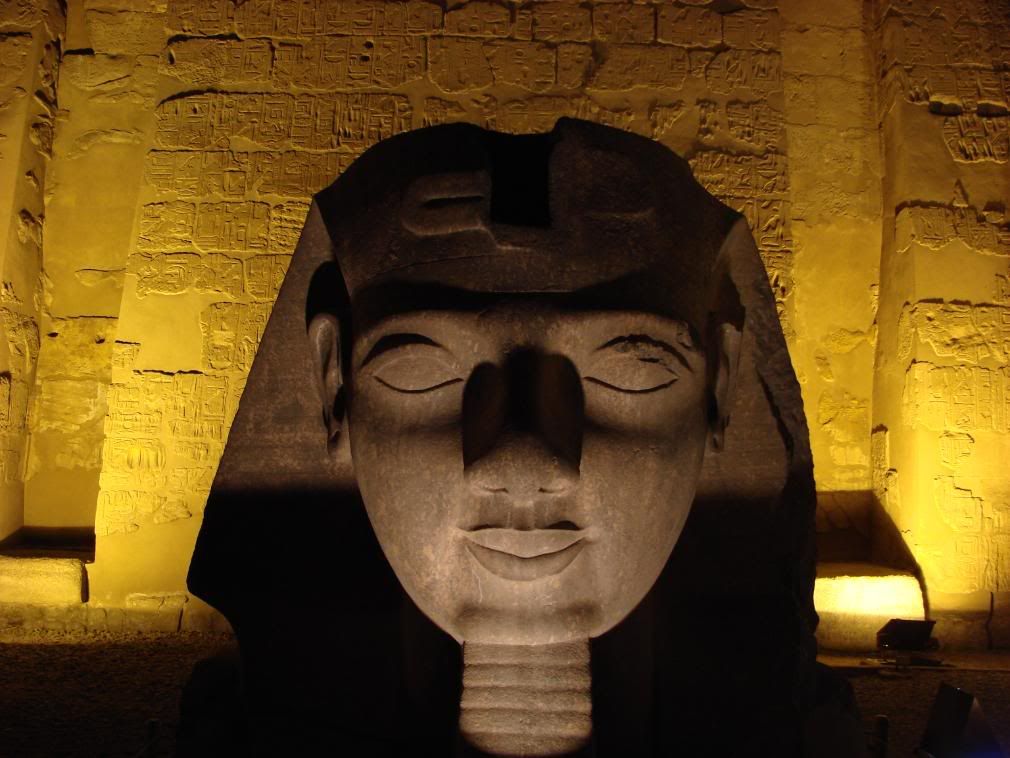 Next was the site of Deir al-Bahri, which was an amazing series of terraces of the Temple of Hatshepsut (a powerful female pharaoh) rising out of the limestone cliffs of the mountains. We also visited some of the tombs of the non-royalty, which were not quite as impressive but were very well-preserved. In the evening, we went shopping which was rather annoying as the shop guys were relentless in their attempts to entice you into their stores. Priti bought some pendants as gifts and Jason bought a scrabe beetle ring that is supposed to bring good luck. Then we went to Luxor Temple at night which was all lit up and mesmerizing to behold.
Next was the site of Deir al-Bahri, which was an amazing series of terraces of the Temple of Hatshepsut (a powerful female pharaoh) rising out of the limestone cliffs of the mountains. We also visited some of the tombs of the non-royalty, which were not quite as impressive but were very well-preserved. In the evening, we went shopping which was rather annoying as the shop guys were relentless in their attempts to entice you into their stores. Priti bought some pendants as gifts and Jason bought a scrabe beetle ring that is supposed to bring good luck. Then we went to Luxor Temple at night which was all lit up and mesmerizing to behold.We were pretty tired from all the traveling so we opted out of a 15 hour bus ride around the Sinai peninsula and took an overpriced boat across instead. On the boat, when it started raining, we realized Jason had left his rain gear in India…doh! No wonder his bags had been so much easier to pack up. Our first stop on Sinai was Hurghada, which is a glaring example of tourism run amok (and in Egypt that is saying a lot). Dozens of unfinished hotels littered the beaches and the coral reefs were in awful shape. We went on a few dives, which were the cheapest thus far ($35 for two plus lunch on the boat) but the dumb divemaster took us to a spot with a strong current going against us. We ended up getting stuck there for over a week because the ferry across the water got cancelled twice and doesn’t run everyday. At least we met some cool locals (who in reality were a quartet of conmen but spared us since we made it clear we weren’t going to buy anything) who showed us a good time at the local belly dancing club. We learned that Egypt is sort of the flip side of SE Asia, in that young male prostitutes hire themselves out to hordes of older European women. For some strange reason, the converter we normally used did not work in our hotel but another bulky (and heavy) converter that Jason had used while studying in Oxford, did work. This marked the last remaining unused item that we had brought with us on the trip, and Jason was mighty thankful that he hadn’t thrown it away.
Ten days later, we finally made it to Sharm El-Sheikh, which is uncannily similar to Vegas and became famous after a big terrorist attack there in 2002. Jason spent a night at the casino playing poker. Interestingly, not only was the game played with US $, but Egyptian pounds were not even usable at the casino. He was going good until a Russian mafia goon showed up with a
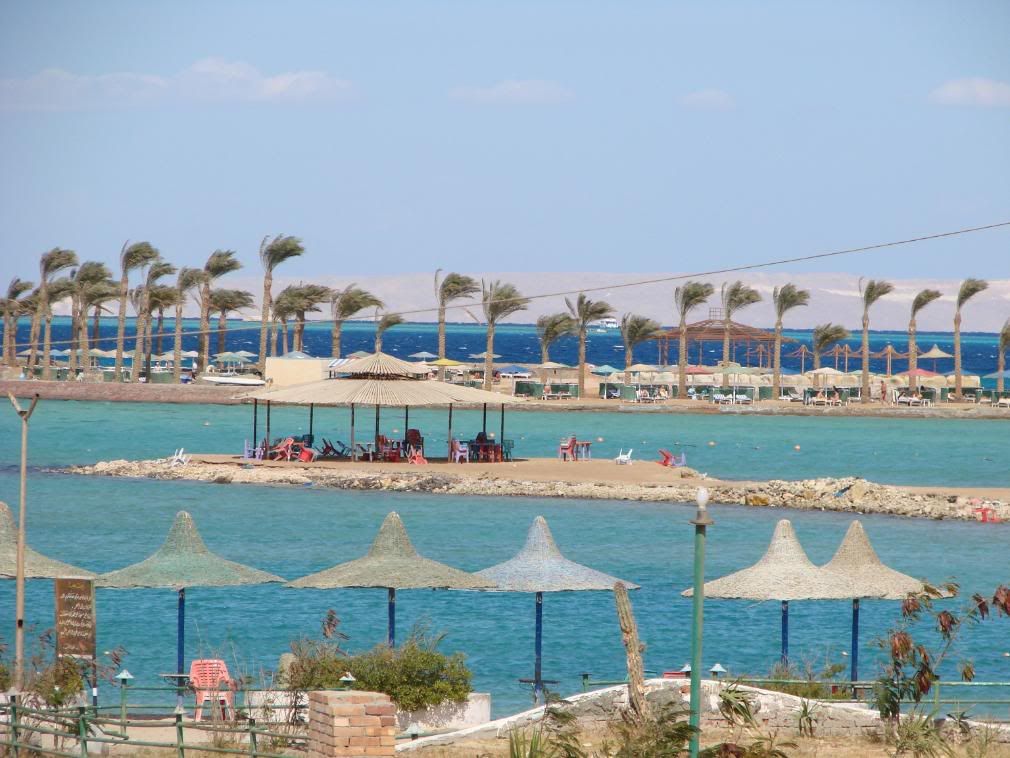 huge diamond studded cross hanging around his neck and a wad of cash worth at least $10,000. It only took one expensive hand of being bullied by this thug for him to walk away from the table. Throughout our time in Sinai, almost all of the locals complained about the nouveau riche Russians because of their obnoxious drinking and disregard for the underwater environment. We wanted to go on another dive but when we showed up at the dive center in the morning, it was completely chaotic and they had no certifications to show they were qualified. Of course we had already paid part of it so rather than waste our entire day fighting with them to give it back, we went out on the boat to snorkel. The coral was superb but the water was freezing cold.
huge diamond studded cross hanging around his neck and a wad of cash worth at least $10,000. It only took one expensive hand of being bullied by this thug for him to walk away from the table. Throughout our time in Sinai, almost all of the locals complained about the nouveau riche Russians because of their obnoxious drinking and disregard for the underwater environment. We wanted to go on another dive but when we showed up at the dive center in the morning, it was completely chaotic and they had no certifications to show they were qualified. Of course we had already paid part of it so rather than waste our entire day fighting with them to give it back, we went out on the boat to snorkel. The coral was superb but the water was freezing cold.We left after a couple days to Dahab, another popular dive spot on the Red Sea but with a much cooler vibe. Jason did some of the best dives yet, including a deep dive down a narrow canyon called the Bells, due to the frequency with which inexperienced divers bang their tanks against the walls during the descent. He also took an excursion to the world-famous Thistlegorm wreck dive, a British casualty from WWII. The dives themselves were incredible, particularly the penetration dive, which involved swimming through the wreck past rows of jeeps, motorcycles, and guns. One room was so narrow that we could only swim through one at a time, and buoyancy control was essential as the clearance above and below was less than a meter. There was also one section where an air pocket had been created above the water, which was cool to see but Jason wisely left his regulator in rather than try to breathe the air. Unfortunately, everything other than the dives was a mess. They put us all on a boat but had nowhere to sleep so we all were sleep-deprived before the dive. Then, the waters were very turbulent and about 1/3 of the passengers got sick on the boat. Because it is one of the most popular dives sites in the world, there were many other boats as well. When we ascended after the first dive, we had to swim underneath another boat which was bobbing up and down with the waves, at times just barely missing the divers underneath. Getting out of the water onto the boat was a total nightmare and one poor woman actually vomited into her regulator (ewww). My dive buddy on the first dive, like many others, decided to forgo the 2nd dive, which was a shame because that was the penetration dive and by far the best. Thus, inexperienced divers should think twice about going to this dive site because it is pretty expensive and the groups are too big. Actually, it seemed like a recipe for disaster but thankfully everything went off without a hitch…this time.
With the extra few weeks we had by pushing back our Kenya flight, we decided to visit Israel and Jordan, so stay tuned.
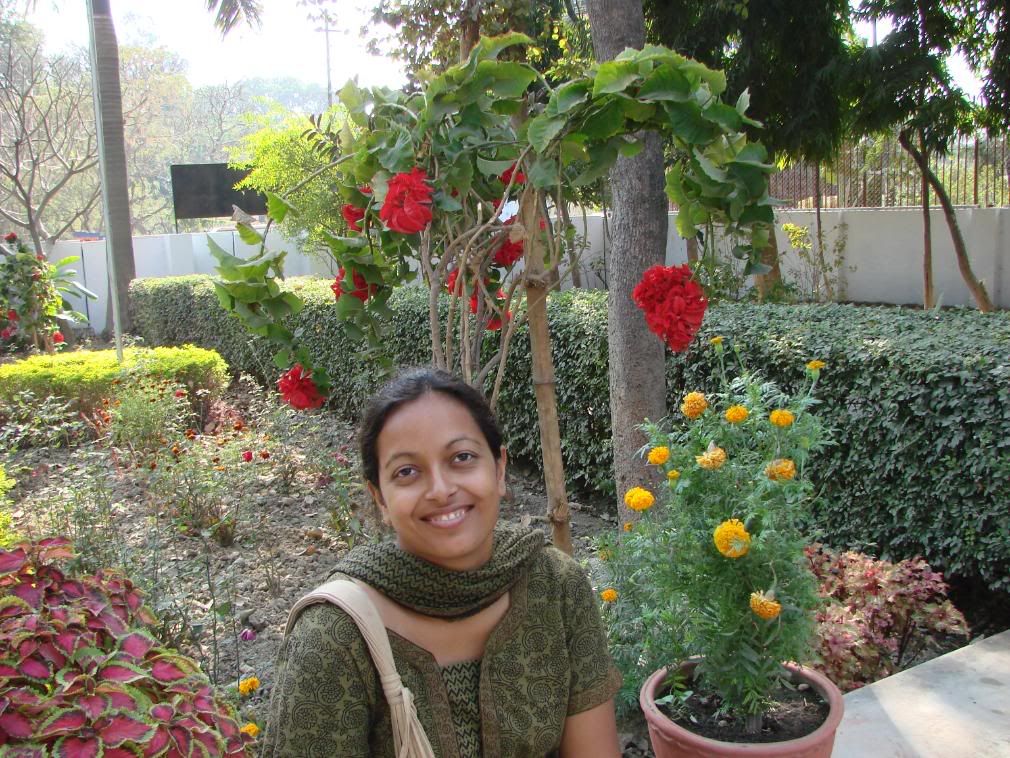 After meeting the family German Shepard named Kush, which means ‘happy’ in Hindi, the reunion was warm and relaxing. As is common among the middle class, they had live-in servants, and we were treated to our favorite Indian dishes. In addition, in India, the family is an extended one. So the three-bedroom condo consisted of Chuni Auntie, her husband and their married son and daughter-in-law. Their other daughter, who had a beautiful baby girl a week after we left (congrats!) lived with her husband three stories down in the same building. During these few weeks we met so many wonderful people and although we don’t remember everyone’s names, we will always remember how they went to every length to ensure that we were enjoying our visit. Thank you!
After meeting the family German Shepard named Kush, which means ‘happy’ in Hindi, the reunion was warm and relaxing. As is common among the middle class, they had live-in servants, and we were treated to our favorite Indian dishes. In addition, in India, the family is an extended one. So the three-bedroom condo consisted of Chuni Auntie, her husband and their married son and daughter-in-law. Their other daughter, who had a beautiful baby girl a week after we left (congrats!) lived with her husband three stories down in the same building. During these few weeks we met so many wonderful people and although we don’t remember everyone’s names, we will always remember how they went to every length to ensure that we were enjoying our visit. Thank you!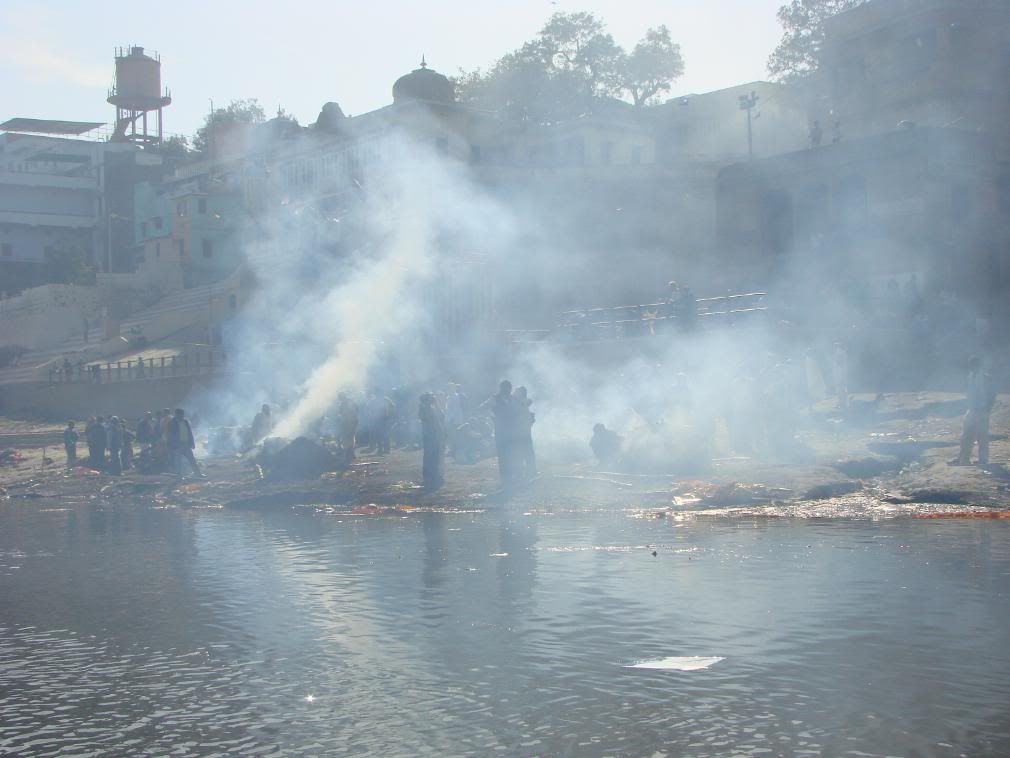 Several of the ghats are used for cremation ceremonies and we witnessed the cremation of several bodies from the boat. Although the air was smoky, it did not smell of burning flesh. We were fortunate to go on the boat ride because the following day, all the captains went on strike due to new higher boatmen’s license fees being imposed by the city government. On the way home, we stopped for some mythai and got the best carmel barfi we’ve ever had.
Several of the ghats are used for cremation ceremonies and we witnessed the cremation of several bodies from the boat. Although the air was smoky, it did not smell of burning flesh. We were fortunate to go on the boat ride because the following day, all the captains went on strike due to new higher boatmen’s license fees being imposed by the city government. On the way home, we stopped for some mythai and got the best carmel barfi we’ve ever had.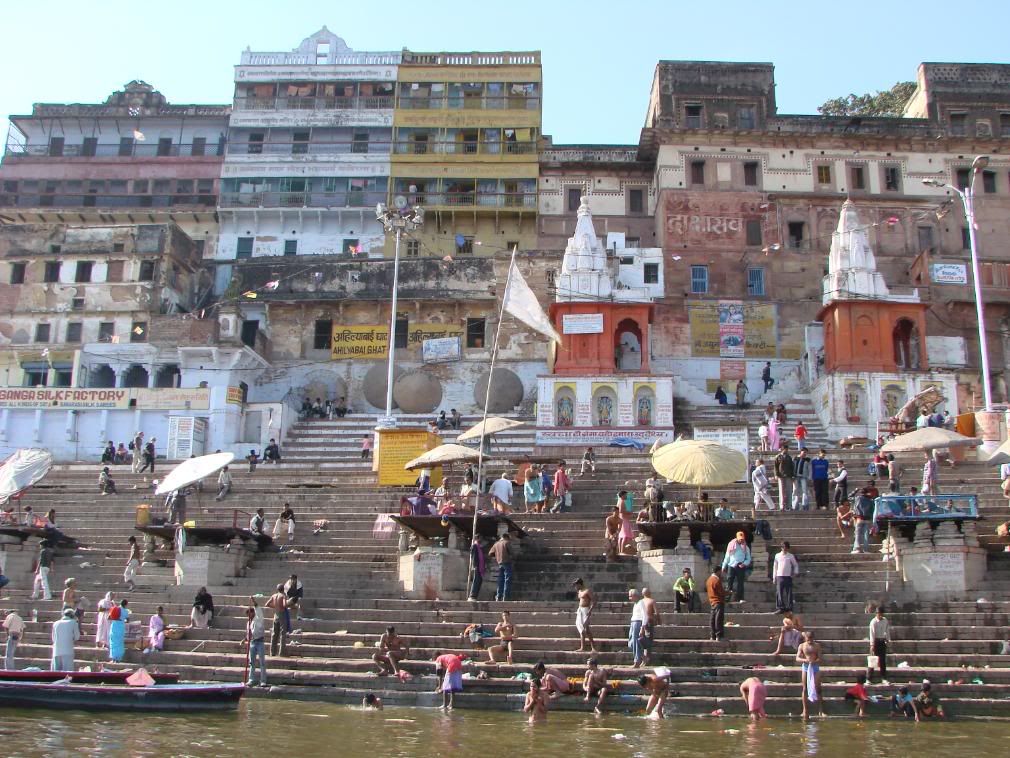 Cars are too wide to fit down the alleys. Priti and her mother had a harrowing experience with an angry bull that was bucking and running down a gulley. Priti ran into a strangers’ home and her mother ran into a nearby hotel for shelter. Although we both were frightened at the time, we laughed about it later. We’re pretty sure this cow was the same one that chased after our fellow globetrekkers Paul and Sapna just a few months earlier since it happened very close to the hotel at which they had stayed.
Cars are too wide to fit down the alleys. Priti and her mother had a harrowing experience with an angry bull that was bucking and running down a gulley. Priti ran into a strangers’ home and her mother ran into a nearby hotel for shelter. Although we both were frightened at the time, we laughed about it later. We’re pretty sure this cow was the same one that chased after our fellow globetrekkers Paul and Sapna just a few months earlier since it happened very close to the hotel at which they had stayed. Later that evening, we saw the Ganga puja, a religious ceremony on the outdoor ghats during which six Hindu priests standing on platforms perform rituals of worship to honor the Ganga River that involve burning ghee (purified butter), incense, ringing bells, and chanting. Although at first the clanging sounded discordant, after awhile it became very hypnotic and peaceful. We began to understand how many of the other travelers we had met claimed to have found their spiritual awakening in India.
Later that evening, we saw the Ganga puja, a religious ceremony on the outdoor ghats during which six Hindu priests standing on platforms perform rituals of worship to honor the Ganga River that involve burning ghee (purified butter), incense, ringing bells, and chanting. Although at first the clanging sounded discordant, after awhile it became very hypnotic and peaceful. We began to understand how many of the other travelers we had met claimed to have found their spiritual awakening in India. On a couple evenings, we attended classical Indian music concerts. Jason went out by himself one evening and, upon returning around midnight, found the entrance gate was locked. The night guard did not speak English but after some hand gestures Jason realized he wanted some money to let him in. After being let in, Jason handed him a 50-rupee note and planned to report him to our host. To our utter amazement, the guard showed up the following morning expecting us to give him more gifts for his generosity the previous evening!
On a couple evenings, we attended classical Indian music concerts. Jason went out by himself one evening and, upon returning around midnight, found the entrance gate was locked. The night guard did not speak English but after some hand gestures Jason realized he wanted some money to let him in. After being let in, Jason handed him a 50-rupee note and planned to report him to our host. To our utter amazement, the guard showed up the following morning expecting us to give him more gifts for his generosity the previous evening!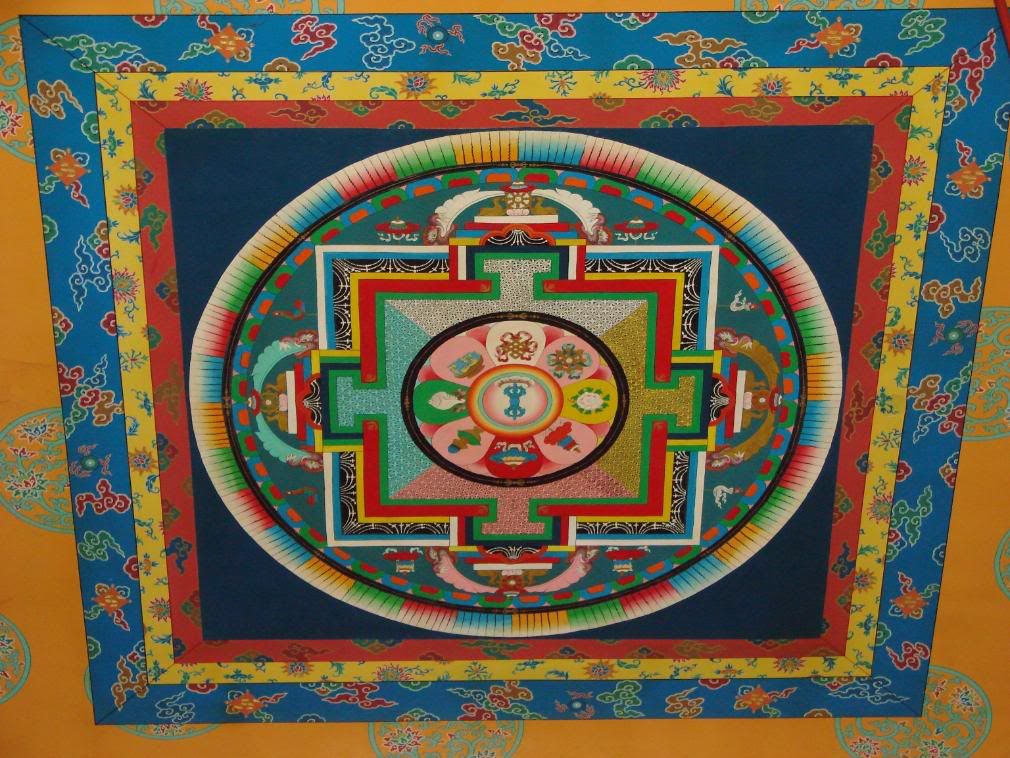 We also visited the five main Buddhist temples which are replicated in the architectural styles of five countries with large proportions of Buddhists: Japan, China, Tibet, Burma, and Thailand (which is still under construction). The Nepalese Buddhist temple had awesome mandala paintings on the ceilings while the Japanese temple had wooden sculptures and serene gardens. The Burmese temple was probably the most interesting since it is highly unlikely that the political situation will become amenable to tourists during our lifetimes.
We also visited the five main Buddhist temples which are replicated in the architectural styles of five countries with large proportions of Buddhists: Japan, China, Tibet, Burma, and Thailand (which is still under construction). The Nepalese Buddhist temple had awesome mandala paintings on the ceilings while the Japanese temple had wooden sculptures and serene gardens. The Burmese temple was probably the most interesting since it is highly unlikely that the political situation will become amenable to tourists during our lifetimes.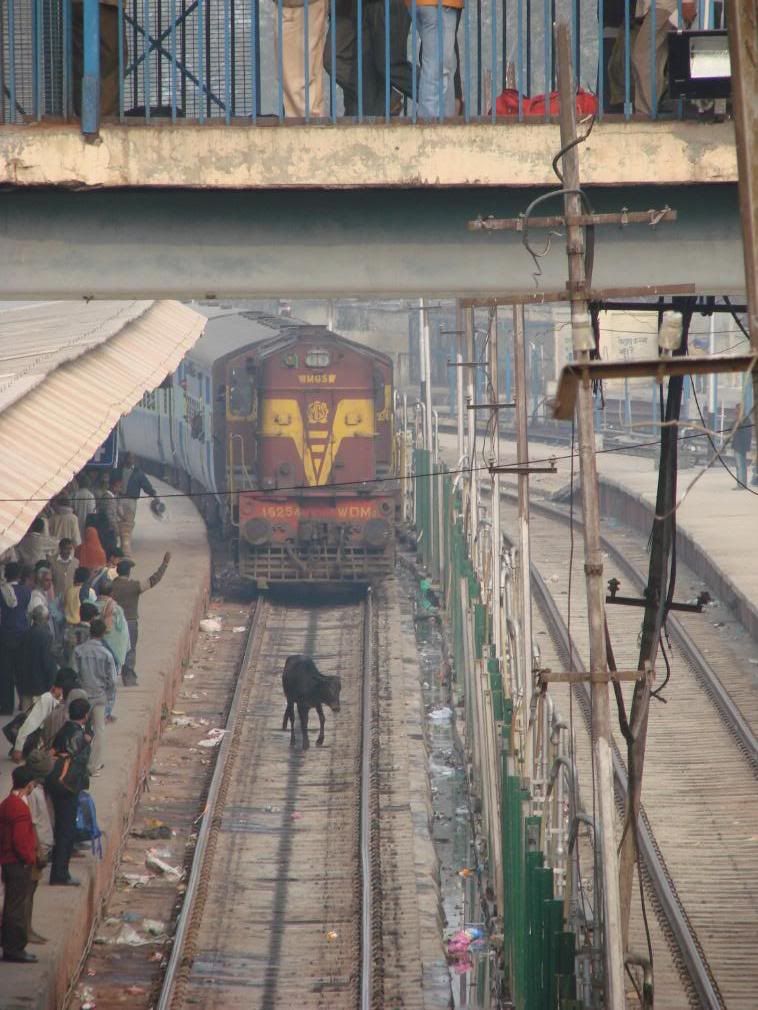 At half past midnight we arrived at the Putna train station, greeted by a couple of Priti’s father’s cousins who then showed us tremendous hospitality at their home. Dinner was prepared and served at one am in the morning! This Uncle and Auntie were renting a flat while their home was being constructed and apologized repeatedly for the cramped quarters. Despite their hospitality, the next day while Priti’s mother stayed with family, Priti and Jason checked into a hotel. It had nothing to do with the cramped quarters but the nausea inducing squatter toilet was too much to handle.
At half past midnight we arrived at the Putna train station, greeted by a couple of Priti’s father’s cousins who then showed us tremendous hospitality at their home. Dinner was prepared and served at one am in the morning! This Uncle and Auntie were renting a flat while their home was being constructed and apologized repeatedly for the cramped quarters. Despite their hospitality, the next day while Priti’s mother stayed with family, Priti and Jason checked into a hotel. It had nothing to do with the cramped quarters but the nausea inducing squatter toilet was too much to handle.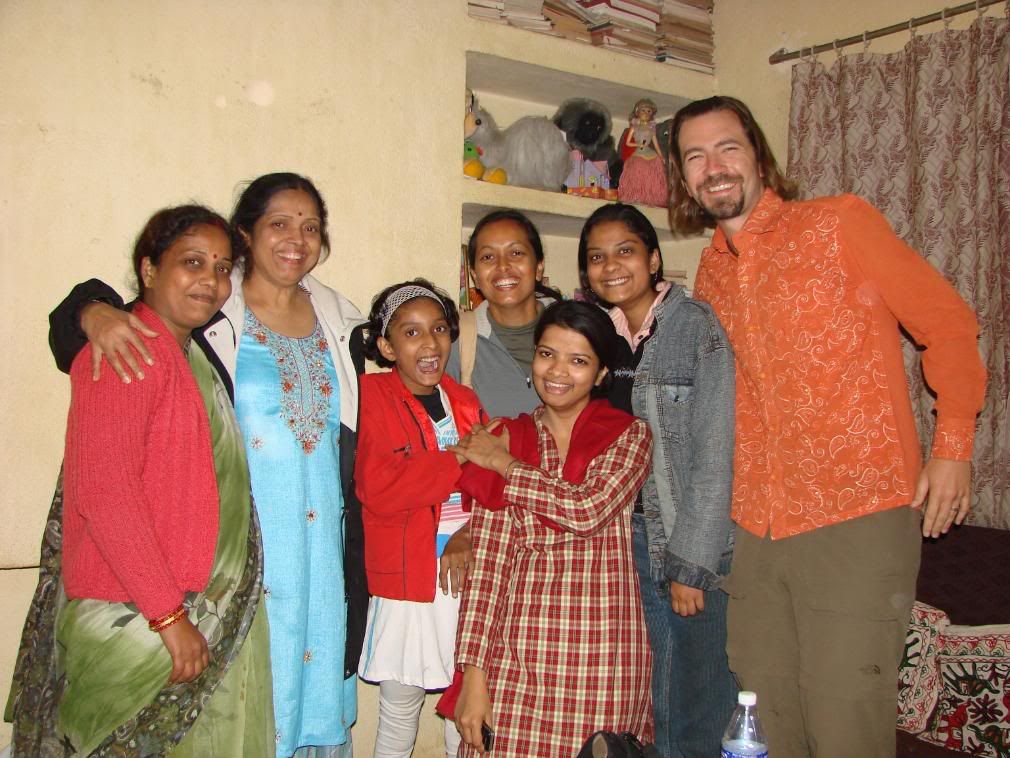 Later we learned that this kind man was a police officer and he was concerned, that with a foreigner (Jason) in the auto, that we might be taken advantage of. The hospitality of our family was unbelievable. We were offered and served cups of chai (Indian tea), sweets, and delicious food and great conversation. Priti’s autistic cousin rubbed her arm and repetitively and affectionately called her ‘Thithee’ (respectfully older sister). Jason tried in vain to learn the rules of cricket while playing with some cousins. Priti’s cousins, all of whom were teenagers or young adults, were educated in English and conversed with Jason without the requirement of a translator.
Later we learned that this kind man was a police officer and he was concerned, that with a foreigner (Jason) in the auto, that we might be taken advantage of. The hospitality of our family was unbelievable. We were offered and served cups of chai (Indian tea), sweets, and delicious food and great conversation. Priti’s autistic cousin rubbed her arm and repetitively and affectionately called her ‘Thithee’ (respectfully older sister). Jason tried in vain to learn the rules of cricket while playing with some cousins. Priti’s cousins, all of whom were teenagers or young adults, were educated in English and conversed with Jason without the requirement of a translator. The bookshop had many great books and Ghandhi had ensured that his books would not be sold for a profit. Priti bought his autobiography for less than one US dollar while Jason picked up The Essence of Hinduism. We both recently read his autobiography and though he was no doubt an incredible person and led India's independence movement, he was also very eccentric and espoused some practices which neither of us found remotely palatable (e.g., bramacharya). That evening, we celebrated Priti’s birthday at the Bellpepper Restaurant where the tandoori chicken in an Afghani curry sauce was divine.
The bookshop had many great books and Ghandhi had ensured that his books would not be sold for a profit. Priti bought his autobiography for less than one US dollar while Jason picked up The Essence of Hinduism. We both recently read his autobiography and though he was no doubt an incredible person and led India's independence movement, he was also very eccentric and espoused some practices which neither of us found remotely palatable (e.g., bramacharya). That evening, we celebrated Priti’s birthday at the Bellpepper Restaurant where the tandoori chicken in an Afghani curry sauce was divine.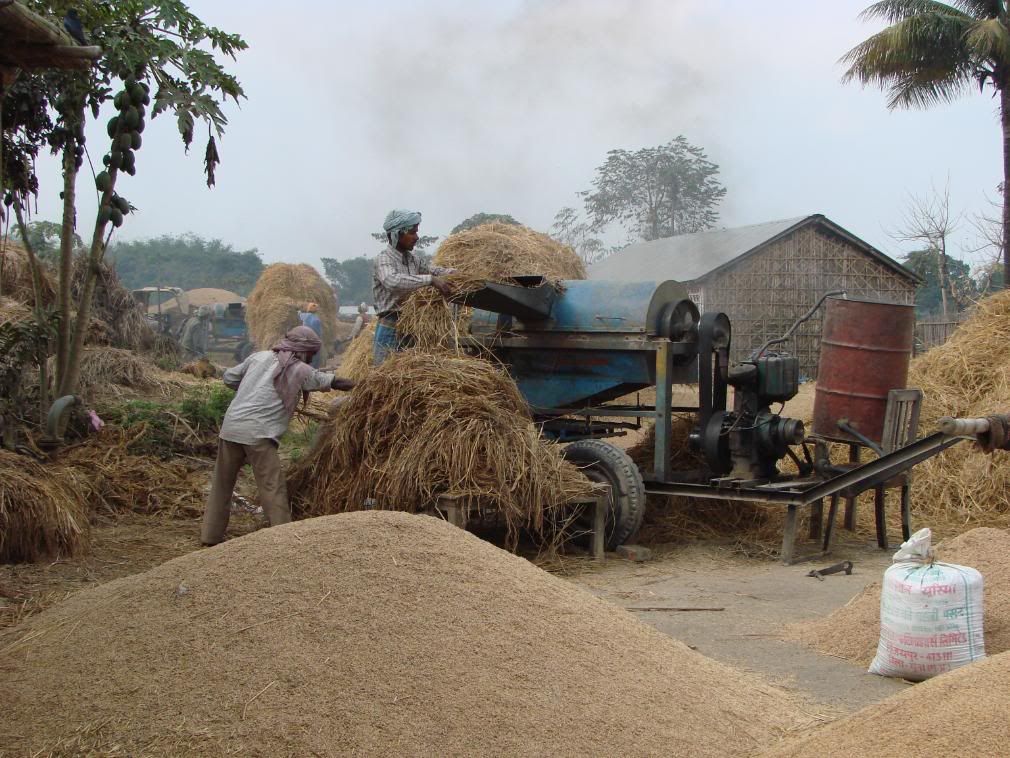 ly hour getting ready for their farming chores. The huts were made of criss-crossed thatched plant material mixed with mud and the roofs were thatched dried long leaves of a native plant. Cows were attached to posts and stood in the small yards of the villagers. Priti’s two Mamas (maternal uncles) and their families live in homes attached to each other with a shared front yard like a traditional extended family in India. We were exhausted from so many overnight train rides within the last week so we slept while Lata excitedly caught up with her two brothers’ families. The last time she had seen her family was eight months ago when she attended her nephew’s wedding. She was pleased to learn that the newlyweds were expecting a baby.
ly hour getting ready for their farming chores. The huts were made of criss-crossed thatched plant material mixed with mud and the roofs were thatched dried long leaves of a native plant. Cows were attached to posts and stood in the small yards of the villagers. Priti’s two Mamas (maternal uncles) and their families live in homes attached to each other with a shared front yard like a traditional extended family in India. We were exhausted from so many overnight train rides within the last week so we slept while Lata excitedly caught up with her two brothers’ families. The last time she had seen her family was eight months ago when she attended her nephew’s wedding. She was pleased to learn that the newlyweds were expecting a baby.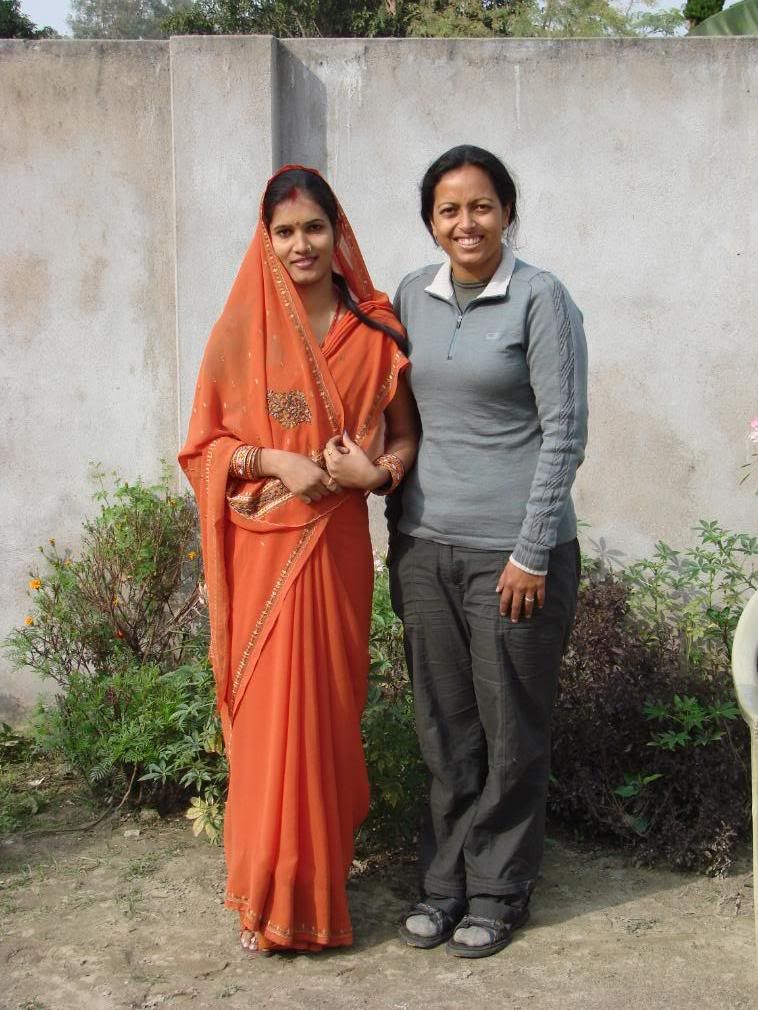 This requires her to stay within the family compound and to not venture outside of the home. It is most often practiced in rural areas. Although Lata observed Purdah, that was forty years ago and she no longer approves of this outdated and oppressive practice. As mentioned previously, Bihar is in a time warp in terms of women’s rights. This new bride did almost all the chores and cooking with some help from her mother-in-law. Although she described being content to practice purdah, it was apparent that she missed going outside and would stand at the doorway when Priti and her teenage cousin Puja played badminton in the front courtyard. Priti suggested that they switch clothes and exchange positions, to which her cousin laughed and said that it was impossible. However, on our final day, at Lata's behest (and since she is the oldest she gets to call the shots), the outdated practice of Purdah was momentarily suspended as the entire family went outside to take pictures (see above picture).
This requires her to stay within the family compound and to not venture outside of the home. It is most often practiced in rural areas. Although Lata observed Purdah, that was forty years ago and she no longer approves of this outdated and oppressive practice. As mentioned previously, Bihar is in a time warp in terms of women’s rights. This new bride did almost all the chores and cooking with some help from her mother-in-law. Although she described being content to practice purdah, it was apparent that she missed going outside and would stand at the doorway when Priti and her teenage cousin Puja played badminton in the front courtyard. Priti suggested that they switch clothes and exchange positions, to which her cousin laughed and said that it was impossible. However, on our final day, at Lata's behest (and since she is the oldest she gets to call the shots), the outdated practice of Purdah was momentarily suspended as the entire family went outside to take pictures (see above picture). Some of the organic crops he grows include mangoes, sugarcane, bananas, wheat, rice, potatoes and other vegetables. Nanee, (grandmother) unfortunately, has dementia so when she visits her sons’ homes becomes more confused so we somewhat understood why they wanted to remain in familiar surroundings . Luckily, they have servants to help them with basic daily needs. We all were very excited to see Priti’s grandparents who were thrilled to finally meet Jason. Nana tried talking to Jason in his Bajpuri dialect and soon learned that Jason did not understand a single word and Priti only understood half of what he was saying. (The dialect is different from the language of Hindi but has some words in common.) Priti’s mom was excited to see how the crops were doing and she even picked some potatoes in the fields.
Some of the organic crops he grows include mangoes, sugarcane, bananas, wheat, rice, potatoes and other vegetables. Nanee, (grandmother) unfortunately, has dementia so when she visits her sons’ homes becomes more confused so we somewhat understood why they wanted to remain in familiar surroundings . Luckily, they have servants to help them with basic daily needs. We all were very excited to see Priti’s grandparents who were thrilled to finally meet Jason. Nana tried talking to Jason in his Bajpuri dialect and soon learned that Jason did not understand a single word and Priti only understood half of what he was saying. (The dialect is different from the language of Hindi but has some words in common.) Priti’s mom was excited to see how the crops were doing and she even picked some potatoes in the fields. 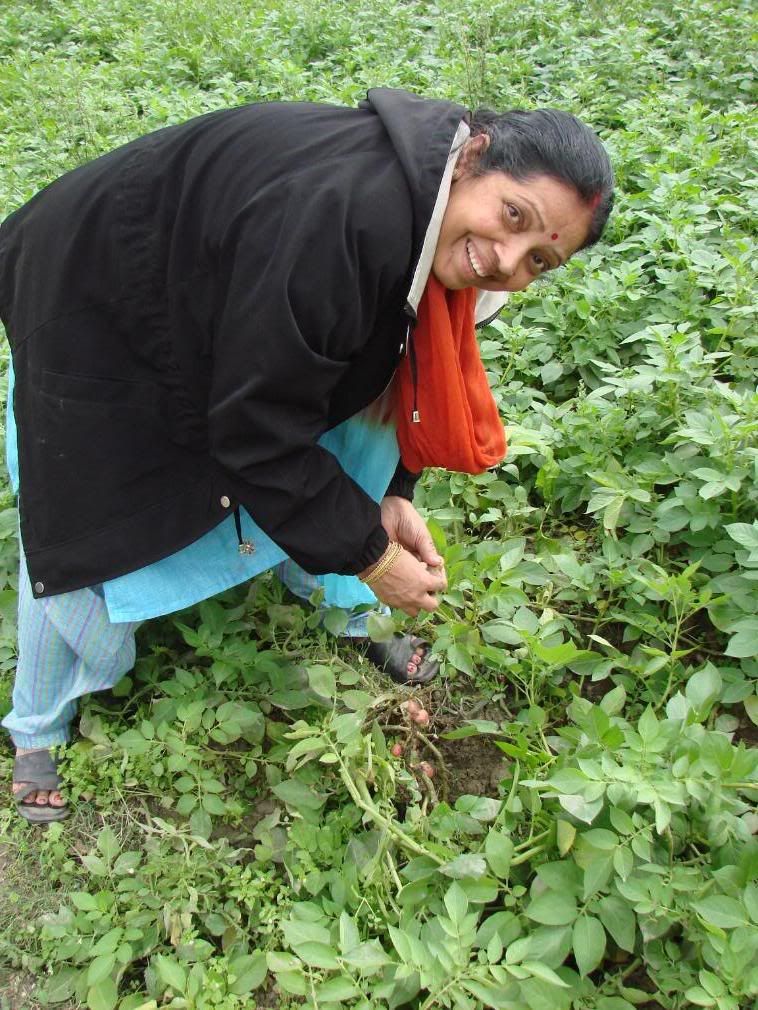 Those curried potatoes were delicious that night too! Too bad it wasn’t mango season since that is both of our favorite fruit. We also watched as workers placed the cut rice stalks from a large mound through a machine that separates the rice grains to be stored and sold by the family. While we were there, some thieves stole about 80 kilos of potatoes during the night.
Those curried potatoes were delicious that night too! Too bad it wasn’t mango season since that is both of our favorite fruit. We also watched as workers placed the cut rice stalks from a large mound through a machine that separates the rice grains to be stored and sold by the family. While we were there, some thieves stole about 80 kilos of potatoes during the night.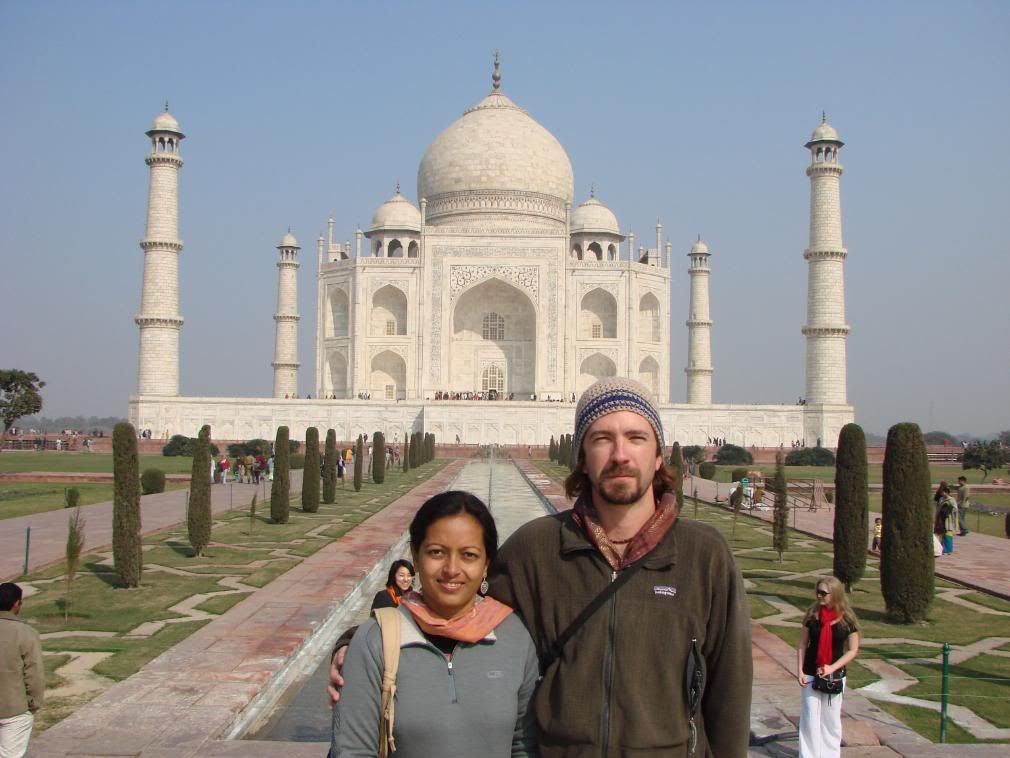 Based on Sapna’s suggestion, Priti decided that since she was born in India, she was Indian and should therefore get the locals discount. She dressed up in her Indian clothes and wrapped a shawl around her shoulders. She looked so Indian that a foreigner took a picture of her in front of the Taj Mahal. Yet, she got questioned not only by the ticket vendor, but the ticket taker, and the security person about where she was born (Baroda, India), where her family was from (Purnia, Bihar), where she lived in India (Ghaziabhad with her relatives near New Delhi which was partly true), and even what was her address in India which spilled off of her tongue easily since she had memorized her cousin’s address. So Priti somehow managed to pay 20 rupees to see the Taj Mahal. Shockingly, Jason managed to get in for free. He had to deposit his electronic goods at security with the exception of the camera and then walked past security.
Based on Sapna’s suggestion, Priti decided that since she was born in India, she was Indian and should therefore get the locals discount. She dressed up in her Indian clothes and wrapped a shawl around her shoulders. She looked so Indian that a foreigner took a picture of her in front of the Taj Mahal. Yet, she got questioned not only by the ticket vendor, but the ticket taker, and the security person about where she was born (Baroda, India), where her family was from (Purnia, Bihar), where she lived in India (Ghaziabhad with her relatives near New Delhi which was partly true), and even what was her address in India which spilled off of her tongue easily since she had memorized her cousin’s address. So Priti somehow managed to pay 20 rupees to see the Taj Mahal. Shockingly, Jason managed to get in for free. He had to deposit his electronic goods at security with the exception of the camera and then walked past security. 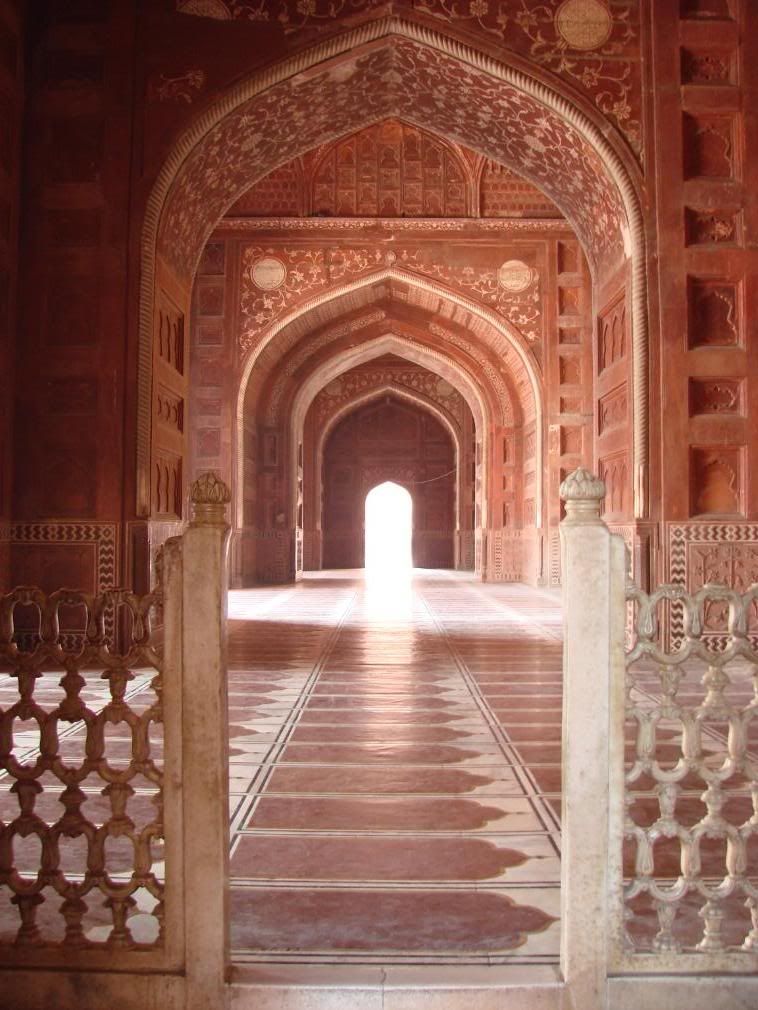 No one stopped him and Jason didn’t even know that he had gone through the entrance until he met Priti in the courtyard at which point she described her interrogation, and he replied with, “The entrance was out there? I thought it was actually to go into the Taj Mahal.” Somehow Jason, “the Foreigner” managed to get into Taj Mahal compound for free and Priti, “the Indian” paid 20 rupees, a mere fifty cents! Haha, suckers!
No one stopped him and Jason didn’t even know that he had gone through the entrance until he met Priti in the courtyard at which point she described her interrogation, and he replied with, “The entrance was out there? I thought it was actually to go into the Taj Mahal.” Somehow Jason, “the Foreigner” managed to get into Taj Mahal compound for free and Priti, “the Indian” paid 20 rupees, a mere fifty cents! Haha, suckers!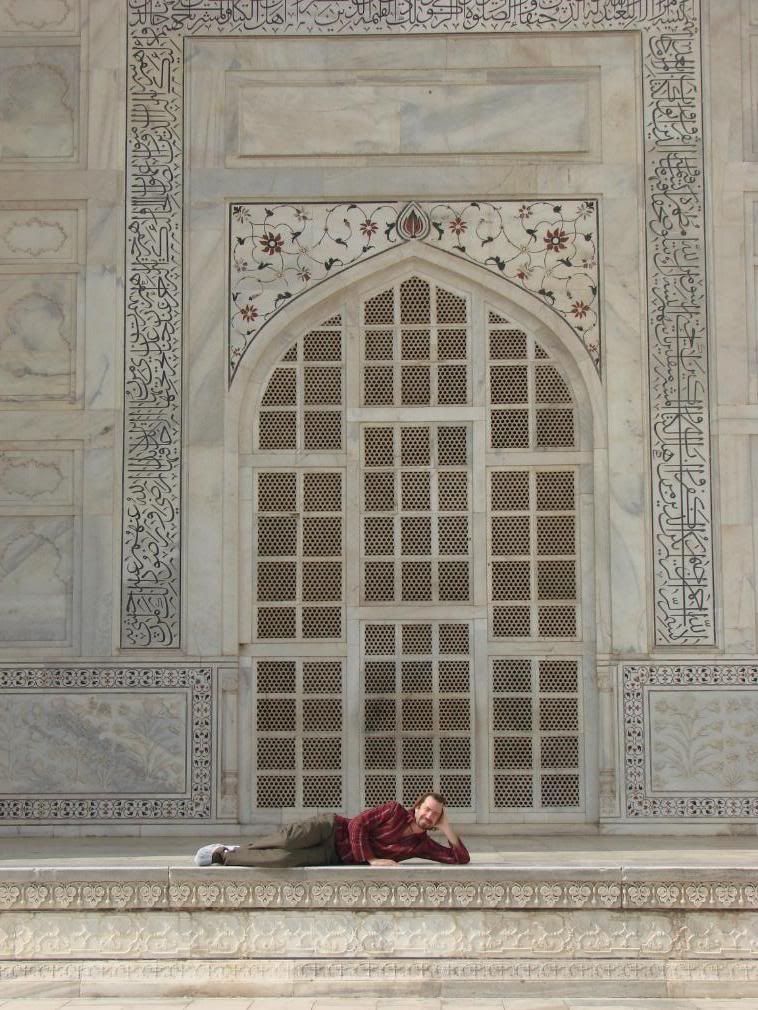 It was the last sight seen in India before we headed back to New Delhi to see Priti’s mom and family. Then, the following day, we continued on our travels by flight to Cairo, Egypt.
It was the last sight seen in India before we headed back to New Delhi to see Priti’s mom and family. Then, the following day, we continued on our travels by flight to Cairo, Egypt.
